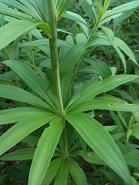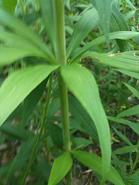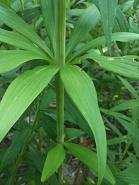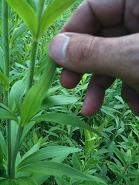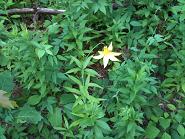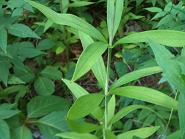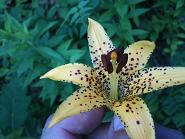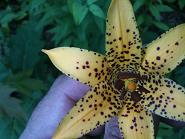Transformational Gardening
June 2010 Foraging Experiences
(Back to:
May 2010 Foraging Experiences)
(Forward to:
July 2010 Foraging Experiences)
June 1, 2010
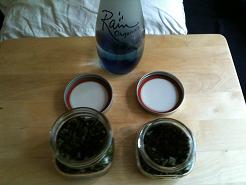
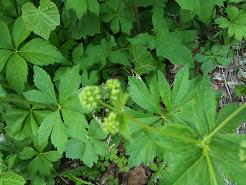 My first Maryland Black Snakeroot tincture! See the description of this amazing plant
in the
Sanicula marilandica May Foraging Experiences section. Yesterday, I picked about 10
out of 50 plants in the area, washed the leaves and roots and then let them dry out a
bit until today. It took about 10 plants to make 1-1/2 pints of tincture.
(I also sprained my ankle on the way down the hill -- a sign to stay out of the field
for the first part of this week and catch up on my garden and other tasks.)
My first Maryland Black Snakeroot tincture! See the description of this amazing plant
in the
Sanicula marilandica May Foraging Experiences section. Yesterday, I picked about 10
out of 50 plants in the area, washed the leaves and roots and then let them dry out a
bit until today. It took about 10 plants to make 1-1/2 pints of tincture.
(I also sprained my ankle on the way down the hill -- a sign to stay out of the field
for the first part of this week and catch up on my garden and other tasks.)
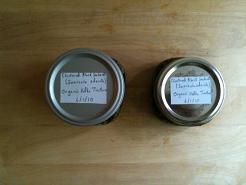 It will be very interesting to see if my own teas and medicines made from
freshly-picked herbs are more potent than the typical (and often non-wildcrafted)
store-bought herbal medicines.
It will be very interesting to see if my own teas and medicines made from
freshly-picked herbs are more potent than the typical (and often non-wildcrafted)
store-bought herbal medicines.
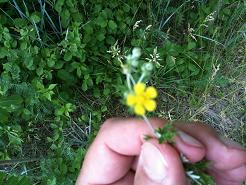
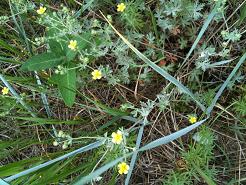 This is the second of six New Hampshire cinquefoils that I am profiling.
I profiled the
Sulphur Cinquefoil in May. It is getting easier to tell them apart and the
Cinquefoil Identification page is helping. Silver Cinquefoil is a 6 to 12 inch plant
with leaves that contain 5-7 palmately-divided leaflets. The leaflets have a silver
back and a bird‘s-foot like toothing (unlike the other cinquefoils). The flower
is a 5-petals and yellow. While the images to the right seem to show a very light-colored
almost sulphur-colored yellow flower, the sunlight made it seem lighter-colored than it
really is.
This is the second of six New Hampshire cinquefoils that I am profiling.
I profiled the
Sulphur Cinquefoil in May. It is getting easier to tell them apart and the
Cinquefoil Identification page is helping. Silver Cinquefoil is a 6 to 12 inch plant
with leaves that contain 5-7 palmately-divided leaflets. The leaflets have a silver
back and a bird‘s-foot like toothing (unlike the other cinquefoils). The flower
is a 5-petals and yellow. While the images to the right seem to show a very light-colored
almost sulphur-colored yellow flower, the sunlight made it seem lighter-colored than it
really is.
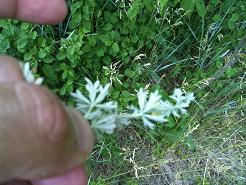
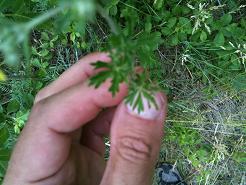 Common Cinquefoil (Potentilla simplex) is the most common of the cinquefoils in
my area and will be profiled next. The Canadian Dwarf Cinquefoil is one I need to locate.
It is only 2 to 6 inches high and the leaflets have teeth only on the top 1/2 of the
leaflet (unlike the Common Cinquefoil leaflet that has teeth on the top 2/3rds).
The other cinquefoils, Norwegian Cinquefoil (Potentilla norvegica) (has
leaves with only 3 leaflets) and Dwarf Mountain Cinquefoil (Potentilla
robbinsiana) (1/2 to 2 inch plant only found in alpine regions) will be profiled
if they are found.
Common Cinquefoil (Potentilla simplex) is the most common of the cinquefoils in
my area and will be profiled next. The Canadian Dwarf Cinquefoil is one I need to locate.
It is only 2 to 6 inches high and the leaflets have teeth only on the top 1/2 of the
leaflet (unlike the Common Cinquefoil leaflet that has teeth on the top 2/3rds).
The other cinquefoils, Norwegian Cinquefoil (Potentilla norvegica) (has
leaves with only 3 leaflets) and Dwarf Mountain Cinquefoil (Potentilla
robbinsiana) (1/2 to 2 inch plant only found in alpine regions) will be profiled
if they are found.
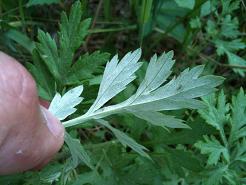
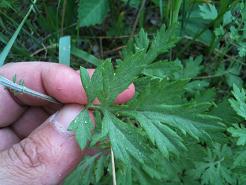 I wandered up to this weed and said, “Hmmm. That looks like Mugwort!”
I must have seen it in a book or something. When I got home, I confirmed that it
is, in fact, Mugwort. A mature plant grows 2 to 4 feet tall. It has alternate leaves
that are deeply dissected (cut-out) in parts of the leaf. The front of the leaves
are green, but the back is covered with a silvery bed of hairs. As the leaf dries,
this silvery bed of hairs feels more like a soft cotton or velvet. Notice how the
edges of the leaves are pointy. As Mugwort leaves mature, the leaf lobes become
much bigger. The links to the pictures below show younger to older Mugwort leaves:
I wandered up to this weed and said, “Hmmm. That looks like Mugwort!”
I must have seen it in a book or something. When I got home, I confirmed that it
is, in fact, Mugwort. A mature plant grows 2 to 4 feet tall. It has alternate leaves
that are deeply dissected (cut-out) in parts of the leaf. The front of the leaves
are green, but the back is covered with a silvery bed of hairs. As the leaf dries,
this silvery bed of hairs feels more like a soft cotton or velvet. Notice how the
edges of the leaves are pointy. As Mugwort leaves mature, the leaf lobes become
much bigger. The links to the pictures below show younger to older Mugwort leaves:
Young Mugwort Leaves
Intermediate-Aged Mugwort Leaves
Older Mugwort Leaves
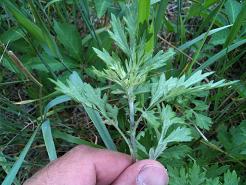
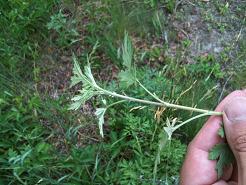 Before we discuss medicinal uses, it is important to differentiate Mugwort from plants
that we might confuse to be Mugwort. Common Ragweed (Ambrosia artemisiifolia) leaves
have some similarity to Mugwort. Carefully compare the top two images of the Mugwort
leaves (above and to the right) with
images of Common Ragweed. Notice how the leaves for Common Ragweed are much more dissected
(larger cut-out sections of the leaves) and that the tips of the leaves for Common Ragweed are
more rounded. After looking at these pictures, it should be very easy to differentiate
Mugwort and Common Ragweed.
Before we discuss medicinal uses, it is important to differentiate Mugwort from plants
that we might confuse to be Mugwort. Common Ragweed (Ambrosia artemisiifolia) leaves
have some similarity to Mugwort. Carefully compare the top two images of the Mugwort
leaves (above and to the right) with
images of Common Ragweed. Notice how the leaves for Common Ragweed are much more dissected
(larger cut-out sections of the leaves) and that the tips of the leaves for Common Ragweed are
more rounded. After looking at these pictures, it should be very easy to differentiate
Mugwort and Common Ragweed.
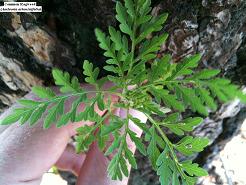
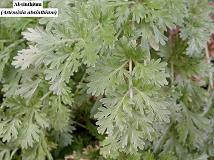 Mugwort (Artemisia vulgaris) is one of several Artemisia species in
New Hampshire. Three species have similar leaves to Mugwort: 1) Absinthium
(Artemisia absinthium). Notice in the picture of Absinthium to the immediate
the right how both the front and back of the leaves are silver and that the edges are
much more rounded than Mugwort. 2) Biennial Wormwood (Artemisia biennis) has
leaves cut similar to that of Mugwort, but Biennial Wormwood is a more erect plant with
a thicker stem and shorter, feathery leaves with a large number of lobes and cut almost
to the midrib. Biennial Wormwood is a taller and thinner plant (in outline), while
Mugwort leaves grow out further from the stem making the plant wider and more like
a bush. 3) Roman Wormwood (Artemisia pontica) has leaves that are Grayish Green
while Mugwort leaves are green in the front and silver and hairy on the back. The
picture to the far right is a recent image of a Common Ragweed leaf.
Mugwort (Artemisia vulgaris) is one of several Artemisia species in
New Hampshire. Three species have similar leaves to Mugwort: 1) Absinthium
(Artemisia absinthium). Notice in the picture of Absinthium to the immediate
the right how both the front and back of the leaves are silver and that the edges are
much more rounded than Mugwort. 2) Biennial Wormwood (Artemisia biennis) has
leaves cut similar to that of Mugwort, but Biennial Wormwood is a more erect plant with
a thicker stem and shorter, feathery leaves with a large number of lobes and cut almost
to the midrib. Biennial Wormwood is a taller and thinner plant (in outline), while
Mugwort leaves grow out further from the stem making the plant wider and more like
a bush. 3) Roman Wormwood (Artemisia pontica) has leaves that are Grayish Green
while Mugwort leaves are green in the front and silver and hairy on the back. The
picture to the far right is a recent image of a Common Ragweed leaf.
 Finally the Mugwort leaf has some slight similarity to the
garden chrysanthemum leaf. In the image to the right, you can see the
leaf of one chrysanthemum, Feverfew (Tanacetum parthenium). Notice that it
has more teeth along the dissected edges. In addition, garden chrysanthemum leaves
are only slightly hair beneath while Mugwort has a very hairy silvery coating
beneath that can feel like velvet.
Finally the Mugwort leaf has some slight similarity to the
garden chrysanthemum leaf. In the image to the right, you can see the
leaf of one chrysanthemum, Feverfew (Tanacetum parthenium). Notice that it
has more teeth along the dissected edges. In addition, garden chrysanthemum leaves
are only slightly hair beneath while Mugwort has a very hairy silvery coating
beneath that can feel like velvet.
Mugwort leaves are well known as an effective treatment for worms and parasites. They are
a bitter tonic for the stomach and liver. The leaves are used for weak digestion,
constipation, to stimulate gastric juice and bile, to treat epilepsy, to treat
menstrual problems, to promote circulation and as a sedative. Mugwort root is used
as a general tonic for people who have diminished strength and energy. In Ayurvedia
Medicine, Mugwort is used to treat cardiac complaints and a general feeling of poor
wellbeing. In Chinese Medicine, in additional to herbal ingestion, Mugwort leaves are
dried and then the leaves rolled and burned next to acupuncture points
(called “moxibustion”) to stimulate these points. Dried Mugwort leaves
are sometimes burned with other herbs or along as part of a “smudging”
or spiritual purification practice.
In Asia, Mugwort is used as a seasoning in several food dishes (soups, rice cakes, mochi
dishes, etc.). I made a Mugwort leaf tea by infusing the dried Mugwort leaves in
very hot water for 15 minutes. It was very pleasant-tasting and makes me want to
gather leaves to dry and use through the Fall and Winter.
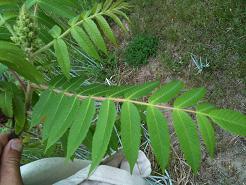
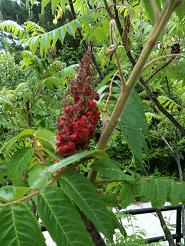 I was not even looking for Sumac trees. Wandering into a hidden section of a
public park I came upon 4-5 Staghorn Sumac trees all in a row. They are low-growing
enough that I will easily be able to reach the fruit when it ready for harvesting
as dark red berries in late July or early August. Last year, I used Sumac fruit
given to me by my friend Judy to make a Sumac lemonaide. I crushed up the berries in
cold water, let it sit for a while, strained it and then added sweetener. Yummy!
I was not even looking for Sumac trees. Wandering into a hidden section of a
public park I came upon 4-5 Staghorn Sumac trees all in a row. They are low-growing
enough that I will easily be able to reach the fruit when it ready for harvesting
as dark red berries in late July or early August. Last year, I used Sumac fruit
given to me by my friend Judy to make a Sumac lemonaide. I crushed up the berries in
cold water, let it sit for a while, strained it and then added sweetener. Yummy!
Staghorn Sumac is a small tree or bush that usually grows from 8 to 20 feet tall.
The leaves are alternate and pinnately compound with 9 to 31 toothed leaflets. The
red hairy fruit grows on the terminal ends of the branches. You can see from the
pictures the red fruit from last year. Sometimes, the previous years‘ fruit
can be picked as late as April, but it is better to pick it around August of the
year it ripens. Staghnorn Sumac has extremely hairy branches that feel like velvet.
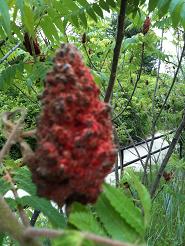
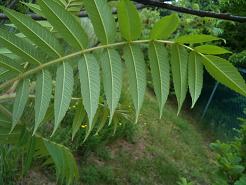 There are other Sumacs that have some similarities. Smooth Sumac (Rhus glabra)
(Edible fruit) is similar to Staghorn Sumac, but has smooth (hairless) stems and leaf
stalks (petioles). Winged Sumac (Rhus copallinum) (Edible fruit) grows 4-10 feet
tall, has raised dots on the stem and the 11-23 glossy leaflets have untoothed margins.
Poison Sumac (Toxicodendron vernix) (Inedible fruit) has white, hairless fruit
hairless stems and untoothed leaf margins. It tends to grow in swampy areas.
There are other Sumacs that have some similarities. Smooth Sumac (Rhus glabra)
(Edible fruit) is similar to Staghorn Sumac, but has smooth (hairless) stems and leaf
stalks (petioles). Winged Sumac (Rhus copallinum) (Edible fruit) grows 4-10 feet
tall, has raised dots on the stem and the 11-23 glossy leaflets have untoothed margins.
Poison Sumac (Toxicodendron vernix) (Inedible fruit) has white, hairless fruit
hairless stems and untoothed leaf margins. It tends to grow in swampy areas.
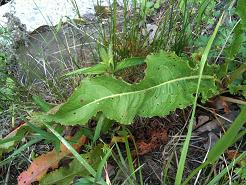
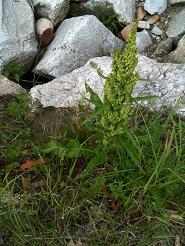
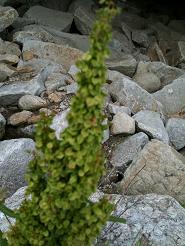
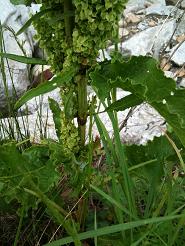
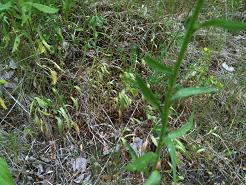
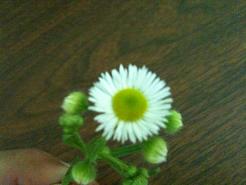 The Eastern Daisy Fleabane is the most common fleabane in Southeastern, New Hampshire.
It grows in waste areas, by roadsides and in overgrown fields. It has a white (and
sometimes pink-tinged) flower rays (80-125 rays) surrounding a yellow disk made up of
100‘s of florets. The stem has noticeable hairs. The leaves are alternate up
the stem. They are hairy, lanceolate in shape and have some teeth (but not many). The
basal leaves are elliptic or round.
The Eastern Daisy Fleabane is the most common fleabane in Southeastern, New Hampshire.
It grows in waste areas, by roadsides and in overgrown fields. It has a white (and
sometimes pink-tinged) flower rays (80-125 rays) surrounding a yellow disk made up of
100‘s of florets. The stem has noticeable hairs. The leaves are alternate up
the stem. They are hairy, lanceolate in shape and have some teeth (but not many). The
basal leaves are elliptic or round.
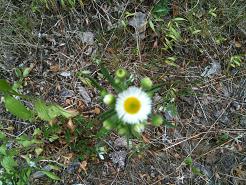
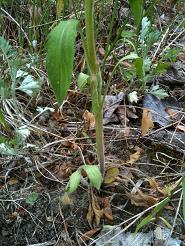 A very similar species is Prarie Fleabane (Rough Fleabane) (Erigeron strigosus).
Prarie Flebane tends to have fewer leaves on the stem. The stem hairs are less
noticeable since they are shorter and appressed against the stem. The leaves of
Prarie Fleabane are mostly hairless. In addition, the stem leaves of Prarie Fleabane
tend grow up to 1 inch wide, while Eastern Daisy Fleabane leaves grow to 2 inches in
width. Hmmm. I am going to keep a close watch on these fleabanes to make sure I can
differentiate between the Eastern Daisy Fleabane and the Prarie Fleabane.
A very similar species is Prarie Fleabane (Rough Fleabane) (Erigeron strigosus).
Prarie Flebane tends to have fewer leaves on the stem. The stem hairs are less
noticeable since they are shorter and appressed against the stem. The leaves of
Prarie Fleabane are mostly hairless. In addition, the stem leaves of Prarie Fleabane
tend grow up to 1 inch wide, while Eastern Daisy Fleabane leaves grow to 2 inches in
width. Hmmm. I am going to keep a close watch on these fleabanes to make sure I can
differentiate between the Eastern Daisy Fleabane and the Prarie Fleabane.
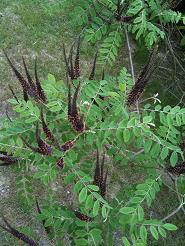
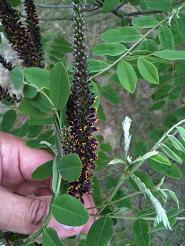 This is a unique-looking plant! I have read in various places online that the seeds can be
used to make a condiment. However, the
Plants For A Future
database for Amorpha fruticosa suggests that there might be a hazard with
alkaloids in this plant. I have not seen any record of traditional uses as a condiment.
The
Plants For A Future
web page does have three references that say that it can used in this way.
This is a unique-looking plant! I have read in various places online that the seeds can be
used to make a condiment. However, the
Plants For A Future
database for Amorpha fruticosa suggests that there might be a hazard with
alkaloids in this plant. I have not seen any record of traditional uses as a condiment.
The
Plants For A Future
web page does have three references that say that it can used in this way.
Desert False Indigo is a 4 to 18 foot shrub with alternate leaves that are about
6 to 18 inches long and odd-pinnate with 11-35 leaflets. The leaves have
relatively short petioles up to 2 inches long. The leaflets are not quite opposite
each other. (See picture below and on the left.) The leaflets are oblong and
untoothed (entire). As you can see from the pictures, the flower which
appears in late May to June is dark purple or blue with bright yellow or orange anthers
(the male part of the stamen). After flowering for 2 to 3 weeks, the flowers are replaced
by 1/4 inch seedpods that contain 1-2 seeds. The lower stems of the Desert False Indigo
are woody with lenticels (pores). The upper stems are dull light green.
Crown Vetch (Securigera varia) (Synonym: Coronilla varia)
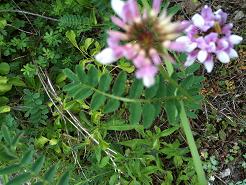
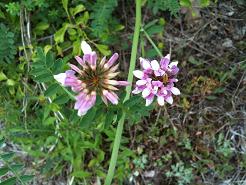 In the process of learning foraging plants, I am trying to identify most of the flowering
plants that I see. Crown Vetch is a vine with alternate pinnately-compound leaves with
15 - 25 leaflets that are 1/2 - 3/4 inches long. There are obvious hairs on the back of
the stem. It flowers in June as a cluster of pink winged flowers forming a crown. The
stems of the flower (inner part of the cluster) are green with red streaks. Another
common vetch is profiled below,
Cow Vetch. Notice that the Crown Vetch has wider leaflets with a much less prominent
leaflet mid-vein as compared to the Cow Vetch. Also, the Cow Vetch has a hairless stem.
In the process of learning foraging plants, I am trying to identify most of the flowering
plants that I see. Crown Vetch is a vine with alternate pinnately-compound leaves with
15 - 25 leaflets that are 1/2 - 3/4 inches long. There are obvious hairs on the back of
the stem. It flowers in June as a cluster of pink winged flowers forming a crown. The
stems of the flower (inner part of the cluster) are green with red streaks. Another
common vetch is profiled below,
Cow Vetch. Notice that the Crown Vetch has wider leaflets with a much less prominent
leaflet mid-vein as compared to the Cow Vetch. Also, the Cow Vetch has a hairless stem.
June 3, 2010
I was not expecting to go foraging today. I was driving to my garden
and my muffler fell out of my car, again! So, drove to the mechanic
with the muffler dragging on the ground. On my walk back, I walked onto
a trail off of a little-travelled road and into a tiny pine tree forest.
There I found a “fern” that I had been trying to identify
since last year. I had gone page-by-page several times through
Peterson Field Guide to Ferns of Northeastern and Central North America
and
Weeds of the Northeast
but still could not find it. A couple of days ago, I read about its many
uses and properties by perusing
Medicinal and Other Uses of North American Plants: A Historical Survey with Special
Reference to the Eastern Indian Tribes. It turns out that it is not a fern
after all, but a member of the Bayberry plant family.
Sweet Fern (Comptonia peregrina)
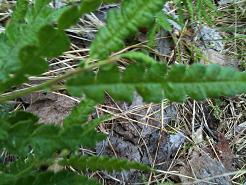
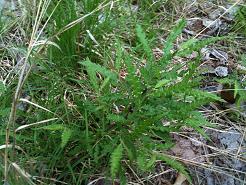 Sweet Fern is a 1-4 foot shrub with many branches and a reddish-brown stem covered
with white hairs. The leaves are alternate up the stems and have scalloped edges
that make them look like fern leaves. Crushing the leaves give off a pleasant aromatic
fragerance. It grows in sandy or rocky soils near pine forest, clearings and in
woodlots.
Sweet Fern is a 1-4 foot shrub with many branches and a reddish-brown stem covered
with white hairs. The leaves are alternate up the stems and have scalloped edges
that make them look like fern leaves. Crushing the leaves give off a pleasant aromatic
fragerance. It grows in sandy or rocky soils near pine forest, clearings and in
woodlots.
Historically, a tea made from the leaves has been used as a weight-loss drink,
to bleeding from the lungs, recovery from fever, diarrhea, ringworm and female problems.
The tea has been used topically to treat rheumatism, poison ivy, bruises and sprains,
itching, sores and toothache.
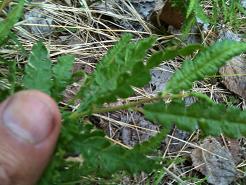
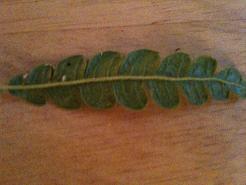 It can be used topically as a body deodorant and an
insect repellent. A chemical in Sweet Fern, Betulin has been
found to kill cancer cells for some types of cancer without harming healthy cells
around the cancer. A tea from the flowering tops has been used to treat headache,
fever, rheumatism and other conditions. Dried leaves thrown on a camp fire are
said to keep mosquitoes away. Native Americans used to line their baskets with
Sweet Fern leaves to help preserve fruit that they were picking.
It can be used topically as a body deodorant and an
insect repellent. A chemical in Sweet Fern, Betulin has been
found to kill cancer cells for some types of cancer without harming healthy cells
around the cancer. A tea from the flowering tops has been used to treat headache,
fever, rheumatism and other conditions. Dried leaves thrown on a camp fire are
said to keep mosquitoes away. Native Americans used to line their baskets with
Sweet Fern leaves to help preserve fruit that they were picking.
I made an infusion of tea by steeping Sweet Fern leaves in very hot spring water
for about 15 minutes. While the Sweet Fern leaves smell great, I can say that the
taste is not pleasant (to me). It is very strong. It reminds me a bit of the Eastern
Hemlock tree tea that I drank last year -- only stronger. Adding a little bit of
honey might make it much more palatable. I will try that next time.
I took some pictures of a small ragweed plant. This is a useful comparison against the
leaves of the Mugwort plant I picked on June 1, 2010. See the
Mugwort foraging section above.
June 5, 2010
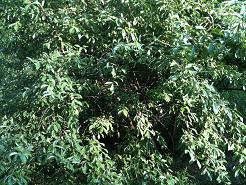
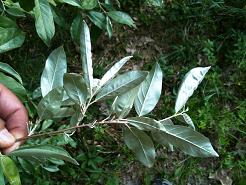 I picked Autumn Olive fruit last year with my friends, Mike and Judy. But I never knew
how to identify this bush. Now that I can identify it, I see it almost everywhere!
The Autumn Olive and its relative, the Russian Olive (Elaeagnus angustifolia)
are deciduous shrubs/small trees with smooth gray bark. They have distinctive silvery
scales/dots on the young stems, leaves, flowers and fruits. The backs of the leaves
are an especially distinctive, somewhat translucent silver color. (See picture to the
right.) The leaves are alternate and slightly oval to lanceolate. They have untoothed
(entire) margins.
I picked Autumn Olive fruit last year with my friends, Mike and Judy. But I never knew
how to identify this bush. Now that I can identify it, I see it almost everywhere!
The Autumn Olive and its relative, the Russian Olive (Elaeagnus angustifolia)
are deciduous shrubs/small trees with smooth gray bark. They have distinctive silvery
scales/dots on the young stems, leaves, flowers and fruits. The backs of the leaves
are an especially distinctive, somewhat translucent silver color. (See picture to the
right.) The leaves are alternate and slightly oval to lanceolate. They have untoothed
(entire) margins.
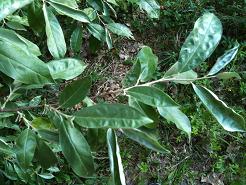
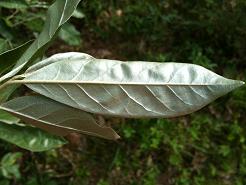 The front of the Autumn Olive leaves are a dull green color, but
are reported to become brighter green towards the Fall as some of the coloration rubs off.
On the other hand, the front of the Russian Olive leaves are a gray-green color and stay
like that all season. The Russian Olive leaves tend to be much thinner (more willow-like
according to Samuel Thayer)
and have a silvery sheen on both sides of the leaf.
The flowers (not shown) are light yellow and appear in May. The
fruit of Autumn Olive is a pink to red color with silver dots while the fruit of
Russian Olive is yellow or orange with silver dots. It is available for harvest in
late August through October. It is high in lycopene. I find the fruit of
the Russian Olive sweeter than that of the Autumn Olive, but the Russian Olive is
much more rare in Southeastern, New Hampshire.
The front of the Autumn Olive leaves are a dull green color, but
are reported to become brighter green towards the Fall as some of the coloration rubs off.
On the other hand, the front of the Russian Olive leaves are a gray-green color and stay
like that all season. The Russian Olive leaves tend to be much thinner (more willow-like
according to Samuel Thayer)
and have a silvery sheen on both sides of the leaf.
The flowers (not shown) are light yellow and appear in May. The
fruit of Autumn Olive is a pink to red color with silver dots while the fruit of
Russian Olive is yellow or orange with silver dots. It is available for harvest in
late August through October. It is high in lycopene. I find the fruit of
the Russian Olive sweeter than that of the Autumn Olive, but the Russian Olive is
much more rare in Southeastern, New Hampshire.
June 6, 2010
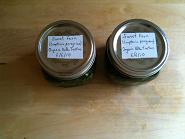
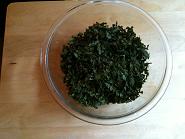 I made Sweet Fern and Mugwort tinctures from the harvest of the foraging trip
in Manchester with my friend, Judy. There was an endless swath of Sweet Fern.
I didn‘t pick nearly enough Mugwort, so I picked more today to add to the
tincture and for some tea. Two pints of Sweet Fern tincture and one cup of
Mugwort tincture.
I made Sweet Fern and Mugwort tinctures from the harvest of the foraging trip
in Manchester with my friend, Judy. There was an endless swath of Sweet Fern.
I didn‘t pick nearly enough Mugwort, so I picked more today to add to the
tincture and for some tea. Two pints of Sweet Fern tincture and one cup of
Mugwort tincture.
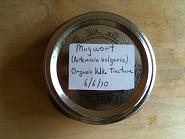
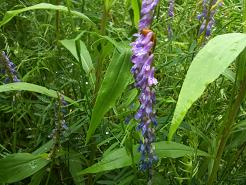
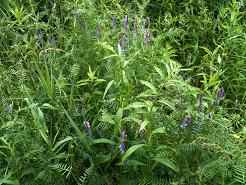 Two vetches seem to be very common in Southeastern, New Hampshire. The
Crown Vetch (Securigera varia) which I profiled earlier and even more
common is the Cow Vetch (which is known by many other names). It's official USDA
Plant Database name is Bird Vetch. Cow Vetch is a vine that has pinnately compound
leaves with 14-31 small leaflets. It has blue (or purple) flowers hanging down that
grow on one side of the stem only. The stems are hairless. Similar Vetches: Crown Vetch
(Securigera varia) has a pink flower growing in a clump and obvious hairs on
the back of the leaf stalk. Crown Vetch has wider leaflets with a much less prominent
leaflet mid-vein as compared to the Cow Vetch. Hairy Vetch (Vicia villosa) has
similar flowers to Cow Vetch except that parts of the flowers are both blue and whitish.
Also, the stalks of Hairy Vetch have hairs.
Two vetches seem to be very common in Southeastern, New Hampshire. The
Crown Vetch (Securigera varia) which I profiled earlier and even more
common is the Cow Vetch (which is known by many other names). It's official USDA
Plant Database name is Bird Vetch. Cow Vetch is a vine that has pinnately compound
leaves with 14-31 small leaflets. It has blue (or purple) flowers hanging down that
grow on one side of the stem only. The stems are hairless. Similar Vetches: Crown Vetch
(Securigera varia) has a pink flower growing in a clump and obvious hairs on
the back of the leaf stalk. Crown Vetch has wider leaflets with a much less prominent
leaflet mid-vein as compared to the Cow Vetch. Hairy Vetch (Vicia villosa) has
similar flowers to Cow Vetch except that parts of the flowers are both blue and whitish.
Also, the stalks of Hairy Vetch have hairs.
June 7, 2010
Below are pictures of an Autumn Olive bush that I found in a local park.
See the
June 5 Autumn Olive foraging entry for more details about this
excellent foraging find!
June 8, 2010
Went for a lunchtime walk today and saw at least six new flowering plants. This is a
good opportunity to identify more plants. Below are five new flowering plants.
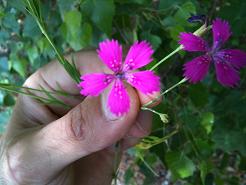
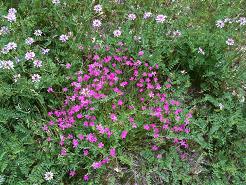 A 5-petal pink flower on a thin, grass-like stalk. The flower petals are toothed at
the tip. There are white and dark red dots at the center of the flower. Leaves are
opposite and lanceolate in shape. They clasp the stem. The stem is hairless. Maiden
Pink is similar to Deptford Pink (Dianthus armeria) except that Deptford Pink
has flowers in clusters atop a stiff erect stem rather than the solitary flower for
Maiden Pink.
A 5-petal pink flower on a thin, grass-like stalk. The flower petals are toothed at
the tip. There are white and dark red dots at the center of the flower. Leaves are
opposite and lanceolate in shape. They clasp the stem. The stem is hairless. Maiden
Pink is similar to Deptford Pink (Dianthus armeria) except that Deptford Pink
has flowers in clusters atop a stiff erect stem rather than the solitary flower for
Maiden Pink.
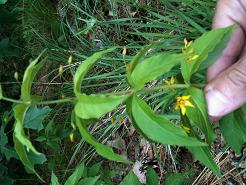
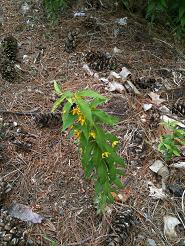 This is a plant I would like to be able to identify next year before the flowers appear.
Whorled Yellow Loosestrife is an erect, 1 to 3 foot plant with whorls of 3 to 6 leaves
going up the stem. The leaves lanceolate in shape and are 2 to 4 inches long. As can be
seen in the pictures, the stem is hairy. Also notice that the upper leaves sometimes turn
a purplish color. Each plant has numerous 5-petal yellow flowers marked with red dots at
the center. Whorled Yellow Loosestrife is similar to Garden Yellow Loosestrife
(Lysimachia vulgaris) except that Garden Yellow Loosestrife has many more flowers
that are less delicate. The Garden Yellow Loosestrife flower petals are much wider and
overlap.
This is a plant I would like to be able to identify next year before the flowers appear.
Whorled Yellow Loosestrife is an erect, 1 to 3 foot plant with whorls of 3 to 6 leaves
going up the stem. The leaves lanceolate in shape and are 2 to 4 inches long. As can be
seen in the pictures, the stem is hairy. Also notice that the upper leaves sometimes turn
a purplish color. Each plant has numerous 5-petal yellow flowers marked with red dots at
the center. Whorled Yellow Loosestrife is similar to Garden Yellow Loosestrife
(Lysimachia vulgaris) except that Garden Yellow Loosestrife has many more flowers
that are less delicate. The Garden Yellow Loosestrife flower petals are much wider and
overlap.
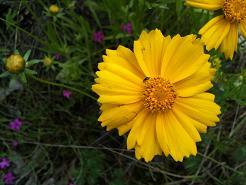
 A large yellow dasiy-like flower that is divided into 8 separate rays. Each flower
ray contains 3 to 5 distinct lobes. The plant is erect and grows 1 to 2 feet tall.
It has a hairy stem. The leaves are long (3-6 inches at the base), untoothed and
lanceolate in shape. Lanceleaf Tickseed is part of the Aster family.
A large yellow dasiy-like flower that is divided into 8 separate rays. Each flower
ray contains 3 to 5 distinct lobes. The plant is erect and grows 1 to 2 feet tall.
It has a hairy stem. The leaves are long (3-6 inches at the base), untoothed and
lanceolate in shape. Lanceleaf Tickseed is part of the Aster family.
A friend of mine wants to make Lanceleaf Tickseed into a flower essence medicinal
remedy. Here is a useful web page on the benefits of
Lanceleaf Tickseed (Coreopsis lanceolata) Flower Essence. Benefits
include appetite suppresent, halting cravings for food/smoking/drugs, help with
insomnia due to inability of shut off thinking at night.
Longbranch Frostweed (Helianthemum canadense)
(Also known as: Crocanthemum canadense)
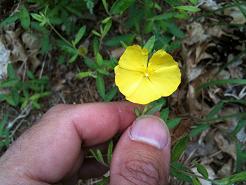
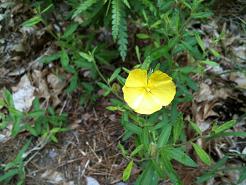 Longbranch Frostweed is an erect plant with a 5-petal yellow flower. The flower petals
overlap sometimes making the flower look like a little yellow satellite dish.
The very center part of the flower is white surrounded by orange-tipped stamen.
Stems have 1 to 2 flowers that bloom in May-June. Leaves are alternate,
narrowly-oblong and taper at both the base and the tip. Stems are scattered and
branching and the branches become longer than the main stem. This differentiates
it from the very similar species, Hoary Frostweed (Helianthemum bicknellii)
where the branches do not become longer than the main stem. In addition, Hoary
Frostweed tends to have more flowers (2-10) and blooms later in the year
(June-July).
Longbranch Frostweed is an erect plant with a 5-petal yellow flower. The flower petals
overlap sometimes making the flower look like a little yellow satellite dish.
The very center part of the flower is white surrounded by orange-tipped stamen.
Stems have 1 to 2 flowers that bloom in May-June. Leaves are alternate,
narrowly-oblong and taper at both the base and the tip. Stems are scattered and
branching and the branches become longer than the main stem. This differentiates
it from the very similar species, Hoary Frostweed (Helianthemum bicknellii)
where the branches do not become longer than the main stem. In addition, Hoary
Frostweed tends to have more flowers (2-10) and blooms later in the year
(June-July).
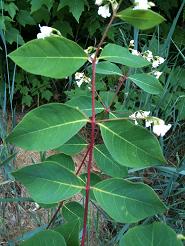
 Spreading Dogbane (Apocynum androsaemifolium) is one of the dogbanes that
can look a little bit like the edible Common Milkweed (Asclepias syriaca).
However, since it is a spreading, bushy plant it looks less like Milkweed than
other more erect dogbanes such as Indian Hemp (Apocynum cannabinum).
Spreading Dogbane (Apocynum androsaemifolium) is one of the dogbanes that
can look a little bit like the edible Common Milkweed (Asclepias syriaca).
However, since it is a spreading, bushy plant it looks less like Milkweed than
other more erect dogbanes such as Indian Hemp (Apocynum cannabinum).
Spreading Dogbane is a 1 to 4 foot bushy plant with opposite leaves that are
slightly drooping, smooth, ovate, untoothed (entire) and are 2 to 4 inches long.
The stems are thin, round and pink to red. (The Common Milkweed stems are mostly
green, squarish, and thick.) The flowers hang downwards and either cluster at the
top and/or arise from the leaf axil. The little 3/8-inch wide flowers are mostly
white with significant streaks of pink and have an inconspicuous dark yellow center.
It flowers from June to August. Spreading Dogbane can be found along roadsides,
fields and woodland borders.
A closely-related dogbane species is Indian Hemp ((Apocynum cannabinum). However,
Indian Hemp has white to greenish-white flowers that cluster at the end of the main stem
or main branches. Spreading Dogbane has pink and white flowers that cluster at
the leaf axils or the end of the main stem or main branches. The flowers
of Spreading Dogbane are larger than that of Indian Hemp. The leaves droop downwards
slighly on the Spreading Dogbane, but do not droop on Indian Hemp. Indian Hemp is a
more erect plant.
The dogbane and milkweed stalks can be collected in the late Fall after the stalks
have dried to use for fibers to weave cord. The
Wildwood Survival School has a summary on harvesting dogbane for cordage.
June 10, 2010
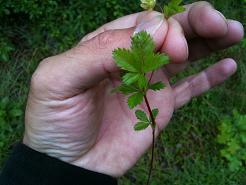
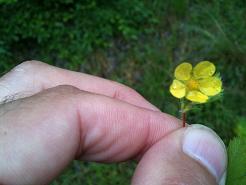 Another cinquefoil for my
Cinquefoil Identification web page. This is the most common of the cinquefoils --
Common Cinquefoil (Potentilla simplex).
Flowers on solitary stem arising out of a leaf axil. The first flower arises from the
2nd leaf axil from the bottom (This differentiates Common Cinquefoil from
Canadian Dwarf Cinquefoil (Potentilla canadensis) which has the flower arise
from the 1st leaf axil from the bottom). While this plant can be tall, often times
the stem droops or folds down over other plants.
Another cinquefoil for my
Cinquefoil Identification web page. This is the most common of the cinquefoils --
Common Cinquefoil (Potentilla simplex).
Flowers on solitary stem arising out of a leaf axil. The first flower arises from the
2nd leaf axil from the bottom (This differentiates Common Cinquefoil from
Canadian Dwarf Cinquefoil (Potentilla canadensis) which has the flower arise
from the 1st leaf axil from the bottom). While this plant can be tall, often times
the stem droops or folds down over other plants.
Leaves are on separate stem from the flower. Leaves are alternate up the stem. They are palmately
divided (all leaflets emerge from same point). For the Common Cinquefoil, the leaf stem is
redish. The stem and leaf petioles are slightly hairy (appressed hairs).
The leaflets have teeth for 3/4ths of their length. (Canadian Dwarf Cinquefoil leaflets have teeth for
only 1/2 of their length.) Some Common Cinquefoil leaflets have teeth for only 1/2 of their length,
but measuring the upper leaflets seems to more consistently show that the teeth run for nearly
3/4ths of their length. The stipules (leaf-like appendage at the base of the petiole/leaf stalk)
are linear-lanceolate and rolled. Plant height: 6 - 20 inches.
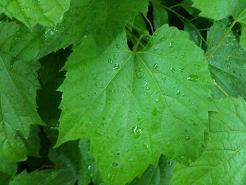

June 11, 2010
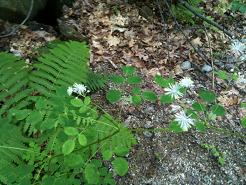
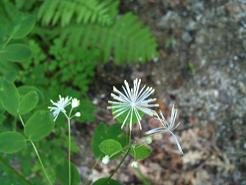 Tall Meadow Rue is common in New Hampshire. It is easily recognized by the
slightly lobed (3-lobed) leaflets and the ball of white spikes the comprise
the flower. The leaf blade is ternately and pinnately decompound. That means
that the leaf blade is divided and sometimes further subdivided into three
(ternately) parts or two (pinnately) parts. Not all of the leaflets have
three lobes. The leaflets are not toothed.
Tall Meadow Rue is common in New Hampshire. It is easily recognized by the
slightly lobed (3-lobed) leaflets and the ball of white spikes the comprise
the flower. The leaf blade is ternately and pinnately decompound. That means
that the leaf blade is divided and sometimes further subdivided into three
(ternately) parts or two (pinnately) parts. Not all of the leaflets have
three lobes. The leaflets are not toothed.
June 13, 2010
Oxeye Daisy (Leucanthemum vulgare) (Previously: Chrysanthemum leucanthemum)
and
Red Clover (Trifolium pratense)
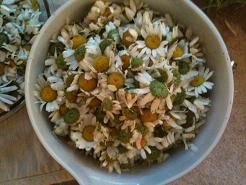
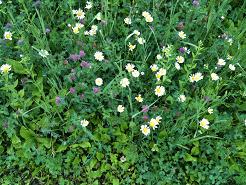 Oxeye Daisy and Red Clover blossom wine was started today!!! Went out and
picked 1-1/2 gallons of Oxeye Daisy blossoms and 1-1/2 gallons of Red Clover blossoms.
That was a lot of looking and picking, picking and looking! Thank you to Kevin for
helping and to Jennifer for finding my more Ground Ivy! The good news is that
I know some fantastic sites for large amounts of Oxeye Daisy and Red Clover. The extra
Oxeye Daisy leaves will be used to spice up a salad. The extra Red Clover blossoms will
be used for tincture and to dry for tea. Red Clover is a fantastic blood cleanser and
is said to be a very important herb in the treatment of cancer.
Oxeye Daisy and Red Clover blossom wine was started today!!! Went out and
picked 1-1/2 gallons of Oxeye Daisy blossoms and 1-1/2 gallons of Red Clover blossoms.
That was a lot of looking and picking, picking and looking! Thank you to Kevin for
helping and to Jennifer for finding my more Ground Ivy! The good news is that
I know some fantastic sites for large amounts of Oxeye Daisy and Red Clover. The extra
Oxeye Daisy leaves will be used to spice up a salad. The extra Red Clover blossoms will
be used for tincture and to dry for tea. Red Clover is a fantastic blood cleanser and
is said to be a very important herb in the treatment of cancer.
I am using the Blossom Wine recipe I found on the
Grow the Changes Blog. I doubled the ingredients so that I could make
1-1/2 gallons (~6 Liters) of wine or use some of that to make a
“Blossom Cider Vinegar” as detailed on the above-mentioned
web page. The ingredients include:
- 12 Quarts of boiling Spring water
- 6-1/2 lbs of honey (or organic raw sugar)
- 2 lbs of chopped dates (or raisins or sultanas)
- 2 lbs of whole wheat kernels
- 2 Tablespoons dried orange peel (or zest and juice of 2 oranges)
- 2 Tablespoons dried lemon peel (or zest and juice of 2 lemons)
- 6 cardamom pods
- 6 cloves
- 2 teaspoons of dry active yeast
I put the instructions and another link to the source of the recipe
(Grow the Change Blog)
below the rest of the pictures. I hope everything
turns out okay with this wine. It's an adventure!
Directions:
- Wash blossoms and place in stone crock (or other food-grade material crock)
- Pour boiling water of blossoms and let sit for 24 hours.
- Filter out blossoms (press out all of the liquid from the blossoms)
- Add remaining ingredients (except the yeast)
- Make sure honey or sugar is dissolved
- Dissolve yeast in 1 cup of water and 2 teaspoons of organic raw sugar and let stand 10
minutes then add to mixture
- Cover crock with cloth or muslin and let stand at room temperature for 3-4 weeks,
stirring daily
- After 3-4 weeks when no more bubbles rise, filter liquid into bottles (wine bottles
or mason jars) and cork or put on lid loosely. At this point, some of the liquid
could be set aside for vinegar-making. See
Grow the Change Blog.
- When fermentation is complete (no gas is released), tighten cork or lids. Store
in cook, dark place until the wine is clear.
- Wine should be ready in approximately 6 months.
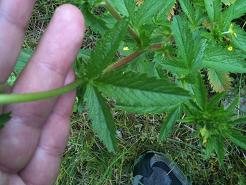
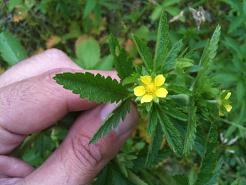 The 4th in the line of cinquefoils for the
Cinquefoil Identification web page. Fortunately, all of the four cinquefoils I have
found so far are very different.
The 4th in the line of cinquefoils for the
Cinquefoil Identification web page. Fortunately, all of the four cinquefoils I have
found so far are very different.
Norwegian Cinquefoil is the only cinquefoil in New Hampshire with 3 leaflets per leaf.
The leaflets are heavily-toothed and, at up to 3 inches, almost as long as Sulphur
Cinquefoil (Potentilla recta) leaflets. The plant tends to have
significant branching and a fairly dense pack of leaves compared to the
other cinquefoils.
The 5-petal yellow flower has big spaces between the petals and the green sepals behind
the flower petals are as long or longer than the flower petals. It is found in clearings,
roadsides and weedy places. I found it in a field with Oxeye Daisy, White Campion,
Red Clover and Flat-topped Aster.
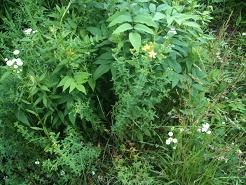

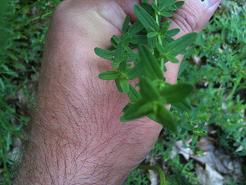
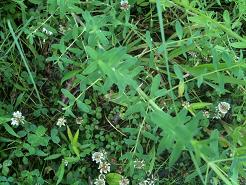
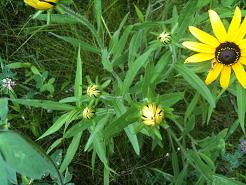
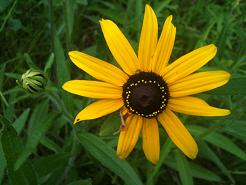
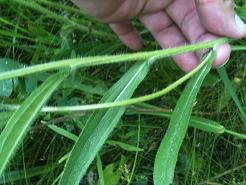
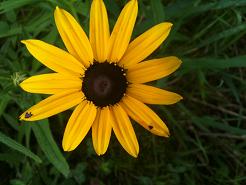
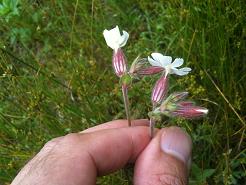
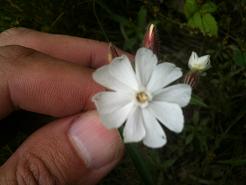

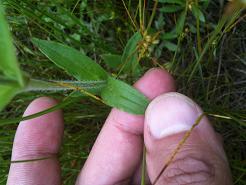
June 14, 2010
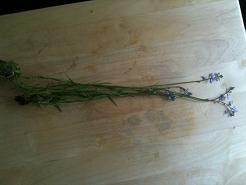
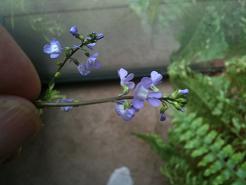
June 15, 2010
It is always useful to know your local poisonous plants so you can avoid them. Water
Hemlock is extremely poisonous and one to avoid. Keep in mind that there is another
poisonous Water Hemlock plant in New Hampshire called Bulbet-Bearing Water Hemlock
(Cicuta bulbifer) which looks somewhat different but is also extremely poisonous.
(See
http://wisplants.uwsp.edu/scripts/detail.asp?SpCode=CICBUL.)
This description applies to the Spotted Water Hemlock (Cicuta maculata). A few
of the noticeable aspects of Spotted Water Hemlock are:
- Carrot-like umbrel (groups of flowers emminating from a single point at the top of
the plant)
- Hairless (smooth) stem
- Purplish parts to the stem. Although some younger stems seem to lack the purple except
around the leaf joints.
- Double Pinnately-Compound Leaves
- Leaflet veins run into the sinuses between the teeth.
- Tends to be found near bodies of water (but not necessarily in the water).
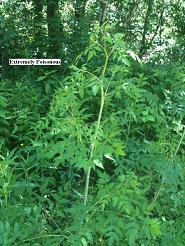
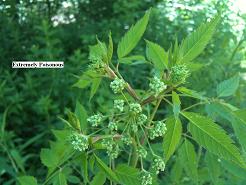 Now let us look at pictures and go over each item in the above list:
Now let us look at pictures and go over each item in the above list:
- Tends to be found near bodies of water (but not necessarily in the water).
These plants are growing on both side of a wide trail. On one side of the trail is a Cattail
marsh and 20 yards from the other side of the trail is a river. The trail sometimes
gets slightly flooded after a rain, but often times these Water Hemlock plants are on dry
ground.
- Carrot-like umbrel (groups of flowers emminating from a single point at the top of
the plant). As you can see in the picture to the immediate right, there are a number of
little umbrels of flowers at the top of the plant. In young plants, I suspect you might not
see these umbrels, so I would not use this as the sole identifying characteristic.
- Hairless (smooth) stem. If you expand the picture to the far right, you may be
able to see that Water Hemlock has a very smooth stem.
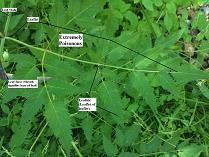
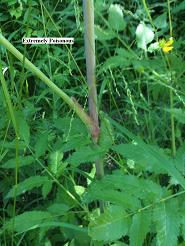
- Purplish parts to the stem. Although some younger stems seem to lack the purple except
around the leaf joints. You can see the purplish part on the picture to the immediate
right. But I did see a younger Water Hemlock without much purple on the stem.
- Double Pinnately-Compound Leaves. I think this is one of the key identifying
characteristics. But in order to see this, you have to know what is a leaf and leaflet.
On a non-woody, herbacious plant, a leaf starts where there is either (1) stipules -- one or
often a pair of basal appendages to the growth of a leaf; or (2) A sheath attached to
the stem to mark the base of the leaf.
As you can see from the picture to the immediate right, there is a sheath that attaches
to the stem to mark the base of the leaf. You can also see that in the picture on the
far right -- the leaf sheath is on the far left of this picture. Note that this picture
just shows one leaf stem. As you go down this leaf stem, you will see leaflets
growing out of each side of the stem. This means that these leaflets are pinnately
compound (they grow out of each side of the leaf stem and all of the way up the leaf
stem). But each of these leaflets also have leaflets that look like toothed leaves.
Click on the picture to the far right to expand and you may be able to click on that
image to expand it further to see the labels that explain the leaflets.
- Leaflet veins run into the sinuses between the teeth. As you can see
from the pictures below on the right, the veins of the leaflets do not run to the
edge of the teeth as they do on most plants, but they run to the sinuses (cavity)
between the teeth on the outer edge of the leaflet.
June 17, 2010
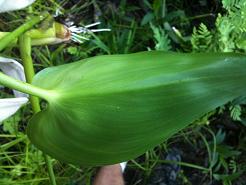
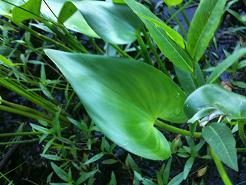
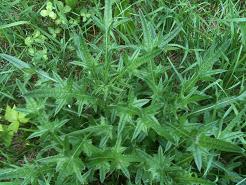

Sheep Laurel (Poisonous) ☠ (Kalmia angustifolia)
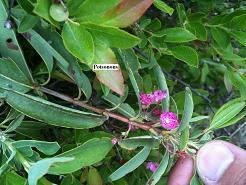

June 18, 2010
Yarrow (Achillea millefolium)
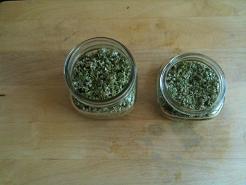
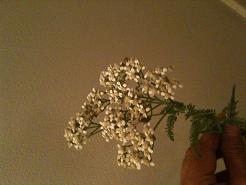

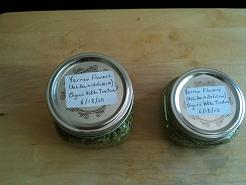
Mullein (Verbascum thapsus)
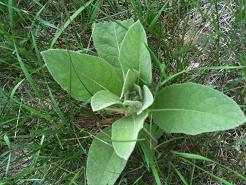

June 19, 2010
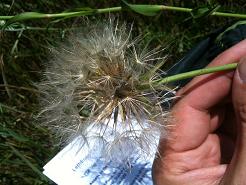
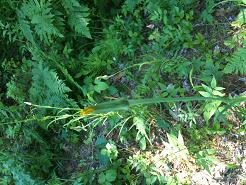
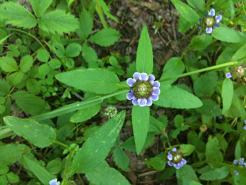
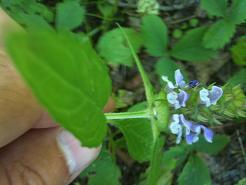
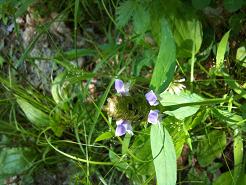
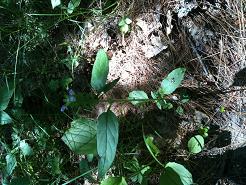
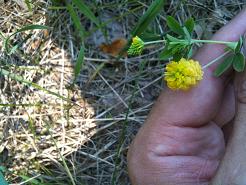

June 20, 2010
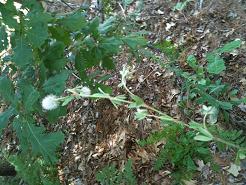
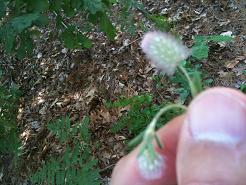
June 21, 2010
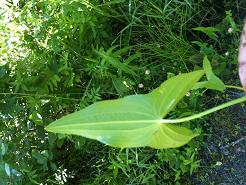
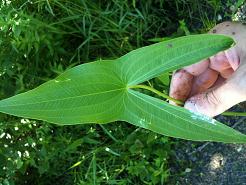 Arrowhead is one of the more important foraging plants. The main crop from Arrowhead
are the potato like roots that can be harvested in the Fall. Arrowhead grows near
the shores of marshes, ponds and rivers, so it will require getting a bit wet to harvest.
Harvesting the root requires feeling in the mud/muck with your hands to grab and pull
off the root or by stomping and moving around in the mud to loosen the tubers until
they float to the surface. Arrowhead root can be prepared by cleaning and peeling the
tubers and then using them like potatoes. They can be cooked for 30 minutes and then
the water drained. They can then be mashed for mashed potatoes. You can dry and then
coarsly grind the mashed potatoes to store as an instant cereal. Undamaged potatoes
can be stored in a root cellar if kept slightly moist and not piled too deeply.
Arrowhead is one of the more important foraging plants. The main crop from Arrowhead
are the potato like roots that can be harvested in the Fall. Arrowhead grows near
the shores of marshes, ponds and rivers, so it will require getting a bit wet to harvest.
Harvesting the root requires feeling in the mud/muck with your hands to grab and pull
off the root or by stomping and moving around in the mud to loosen the tubers until
they float to the surface. Arrowhead root can be prepared by cleaning and peeling the
tubers and then using them like potatoes. They can be cooked for 30 minutes and then
the water drained. They can then be mashed for mashed potatoes. You can dry and then
coarsly grind the mashed potatoes to store as an instant cereal. Undamaged potatoes
can be stored in a root cellar if kept slightly moist and not piled too deeply.
Unopened (curled up) Arrowhead leaves can cooked as a green. The unopened leaves
are available in the Spring to mid-Summer, but as of now I have yet to see any
unopened leaves. The tips of the rhizomes (laterals) can be harvested in the
last Summer and used raw or cooked as a root vegetable. For details on identifying,
harvesting and preparing Arrowhead, please see:
The Forager‘s Harvest by Samuel Thayer
and
Wild Food Adventurer, Volume 1, Number 4 by John Kallas (only newsletter boxed
sets are still available)
Common Arrowhead has very distinctive arrowhead leaves with long, somewhat pointed
tips. One thing that distinguishes Arrowhead from similar looking plants such
as Arrow Arum (Peltandra virginica) is that the veins of the leaves all originate
at the same point -- near the top of the stem. Also, the top backward pointing lobes
of the Common Arrowhead are far larger than other similar looking leaves. Those lobes
cover half or more than half the surface area as the main portion of the leaf.
The second row of pictures below are pictures of the white flowers with a yellow
center. These pictures were taken when the flower started to bloom on July 2, 2010.
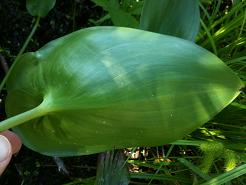
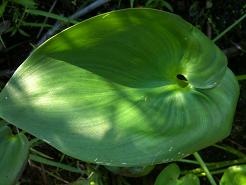
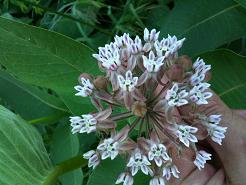
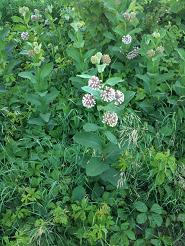
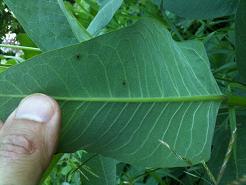
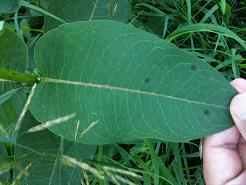

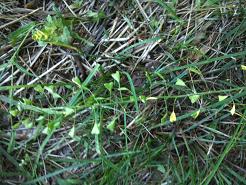
June 22, 2010
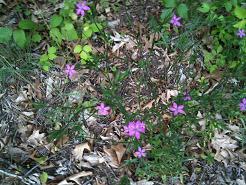
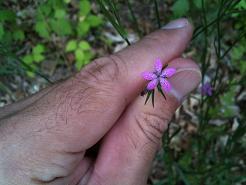
June 24, 2010
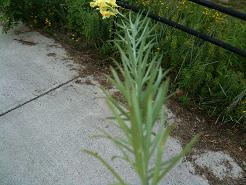
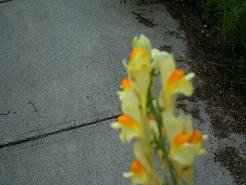 I have not seen Common Toadflax very often -- one plant last year and this year I saw a few plants just
outside a small path leading to a park. Common Toadflax was traditionally
used as a digestive bitter. It stimulates liver and gallbladder secretion and
helps to decongest and repair liver stress from a poor diet or malabsorption.
The whole above-ground portion is used in decoction, infusion or tincture.
I have not seen Common Toadflax very often -- one plant last year and this year I saw a few plants just
outside a small path leading to a park. Common Toadflax was traditionally
used as a digestive bitter. It stimulates liver and gallbladder secretion and
helps to decongest and repair liver stress from a poor diet or malabsorption.
The whole above-ground portion is used in decoction, infusion or tincture.
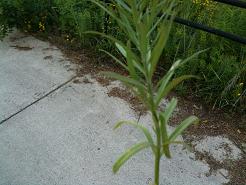
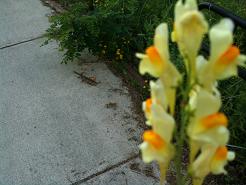 A yellow, 2-lipped flower with bright orange ridges. The leaves are long, very thin
(grass-like) and alternate up the stem. Lower leaves are opposite or whorled. Grows
in dry fields, roadsides and waste places.
A yellow, 2-lipped flower with bright orange ridges. The leaves are long, very thin
(grass-like) and alternate up the stem. Lower leaves are opposite or whorled. Grows
in dry fields, roadsides and waste places.
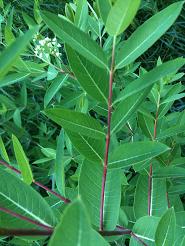
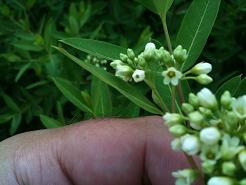 When Dogbane is young it looks somewhat similar to young Milkweed. Milkweed is edible
and Dogbane is inedible. But dried Dogbane stalks can be used to make cord.
When Dogbane is young it looks somewhat similar to young Milkweed. Milkweed is edible
and Dogbane is inedible. But dried Dogbane stalks can be used to make cord.
Mature Dogbane has a top cluster of 5-petal small white flowers. The flowers are
bell-shaped with a green and yellow center. The stem is red and has a round
cross section. The leaves are big, ovate and opposite.
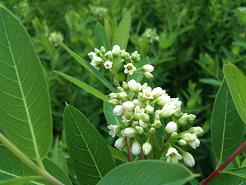
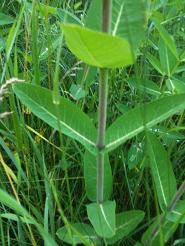 Common Milkweed (Asclepias syriaca) has a stem that is squarish in cross section,
leaf size decreases going up the stalk and overlaps significantly (if folded upward),
leaf bottom and stem is hairy, shoot is shorter and thicker. Common Dogbane has a stem
that is round in cross section, leaf size increases going up the stalk and overlaps
only slightly if any, leaf bottom and stem is smooth and hairless, shoot is taller and
thinner. Young Milkweed stems tend to be green, while young Dogbane stems have a faint
redish bloom or spots.
Common Milkweed (Asclepias syriaca) has a stem that is squarish in cross section,
leaf size decreases going up the stalk and overlaps significantly (if folded upward),
leaf bottom and stem is hairy, shoot is shorter and thicker. Common Dogbane has a stem
that is round in cross section, leaf size increases going up the stalk and overlaps
only slightly if any, leaf bottom and stem is smooth and hairless, shoot is taller and
thinner. Young Milkweed stems tend to be green, while young Dogbane stems have a faint
redish bloom or spots.
June 26, 2010
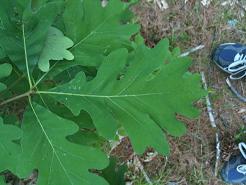
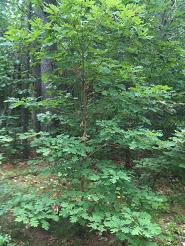 There are a couple of very important reasons to locate a good source of White Oak
trees. The acorns are a very important food source. While any type of oak tree acorns
can be used, the White Oak acorns tends to contain fewer tannis and therefore needs
much less leaching. Inner White Oak bark is a very power medicine. It is especially
useful for persons
who tend towards poor digestion, loose teeth or teeth with lots of cavities, poorly-toned
intestines, swollen spleen and poor nutrient assimilation. It can be combined with
dandelion root in a decoction to help remineralize the bones and teeth.
There are a couple of very important reasons to locate a good source of White Oak
trees. The acorns are a very important food source. While any type of oak tree acorns
can be used, the White Oak acorns tends to contain fewer tannis and therefore needs
much less leaching. Inner White Oak bark is a very power medicine. It is especially
useful for persons
who tend towards poor digestion, loose teeth or teeth with lots of cavities, poorly-toned
intestines, swollen spleen and poor nutrient assimilation. It can be combined with
dandelion root in a decoction to help remineralize the bones and teeth.
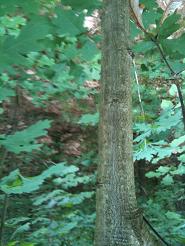
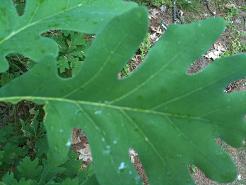 White Oak leaves have rounded lobes. The bark is grayish-silver and looks
like it is stretched thin. The inner bark is white. A recently downed tree or the
branches can be used to harvest the inner bark. White Oak acorns can be harvested
in the Fall.
White Oak leaves have rounded lobes. The bark is grayish-silver and looks
like it is stretched thin. The inner bark is white. A recently downed tree or the
branches can be used to harvest the inner bark. White Oak acorns can be harvested
in the Fall.
June 29, 2010

 This was a confusing and frustrating plant to identify! It looked so much like
Solomon‘s Seal with the exception that the stem forked into two Solomon‘s
Seal-like arching stems and instead of inedible fruit beneath the leaves, there is
a green, 3-parted, triangular pod. With a lot of research and the help of Judy,
we identified this plant. One of the biggest helpful web pages was this Minnesota
web page on Solomon‘s Seal identification and look-alikes:
This was a confusing and frustrating plant to identify! It looked so much like
Solomon‘s Seal with the exception that the stem forked into two Solomon‘s
Seal-like arching stems and instead of inedible fruit beneath the leaves, there is
a green, 3-parted, triangular pod. With a lot of research and the help of Judy,
we identified this plant. One of the biggest helpful web pages was this Minnesota
web page on Solomon‘s Seal identification and look-alikes:
http://minnesotaseasons.com/Identification/Solomon's_Seal_ID.htm
I could tell that it was not Feathery False Solomon‘s Seal
(Maianthemum racemosum) because the leaves do not grow off of little black
buds and there were not flowers or fruit at the end of the stalks. It looked similar
to Rose-Twisted Stalk (Streptopus lanceolatus)
(from the above-mentioned web page), but instead of fruit beneath the leaves it
had that green pod. It was not the Large-Flowered Bellwort from the above-mentioned
web page, but I checked and realized that Sessile Bellwort (Wild Oats) grows in
New Hampshire. It has the exact green pod that grows below this plant! One of the
confusing aspects is that the younger Sessile Bellwort (Wild Oats) does not
look like the pictures to the right or below because the leaves droop significantly
until after the plant flowers and then the leaves stiffen up to look more like
Solomon‘s Seal.
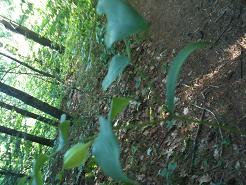
 The leaves are usually 1-1/2 to 3 inches long growing on a stem that is not
straight. The leaves are light green above and slightly whitish below.
The leaf veins are parallel. As mentioned above, the stem forks into two
Solomon‘s Seal-like arching stems. Flowers (not shown) are narrow,
bell-shaped and hang beneath the leaves. After flowering a green, somewhat
round, somewhat triangular pod hangs beneath the leaves. Inside the pod
are tiny round white seeds.
The leaves are usually 1-1/2 to 3 inches long growing on a stem that is not
straight. The leaves are light green above and slightly whitish below.
The leaf veins are parallel. As mentioned above, the stem forks into two
Solomon‘s Seal-like arching stems. Flowers (not shown) are narrow,
bell-shaped and hang beneath the leaves. After flowering a green, somewhat
round, somewhat triangular pod hangs beneath the leaves. Inside the pod
are tiny round white seeds.
Young Sessile Bellwort (Wild Oats) shoots can be stripped of their leaves and
eaten raw in salads or cooked for 10 minutes.
June 30, 2010
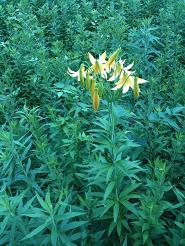
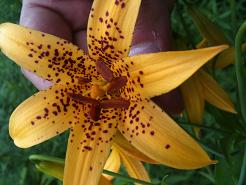 This plant shows quite a bit of variation. The first plant I saw had 6 big flowers
at the top and whorls of 8-10 leaves going up the stem. But most of the Canada
Lilies along the trail had whorls of 4 leaves and only 1 flower at the top (see
2nd row of pictures in the table below). I thought it might be two different
plants, but according to the guidebooks, it just shows quite a bit of variation.
This plant shows quite a bit of variation. The first plant I saw had 6 big flowers
at the top and whorls of 8-10 leaves going up the stem. But most of the Canada
Lilies along the trail had whorls of 4 leaves and only 1 flower at the top (see
2nd row of pictures in the table below). I thought it might be two different
plants, but according to the guidebooks, it just shows quite a bit of variation.

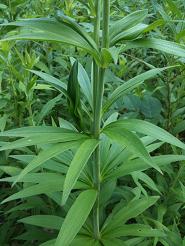 The leaves are lanceolate and appear in whorls of 4-10 leaves on the stem. The veins
beneath the leaves have minute prickles. The large yellow flowers have 3 petals and 3
petal-like sepals (making it seem like it has 6 petals). There are dark redish-brown
spots on the flower petals. There are six stamen with brown anthers. Up to 20 flowers
may be borne on the same plant.
The leaves are lanceolate and appear in whorls of 4-10 leaves on the stem. The veins
beneath the leaves have minute prickles. The large yellow flowers have 3 petals and 3
petal-like sepals (making it seem like it has 6 petals). There are dark redish-brown
spots on the flower petals. There are six stamen with brown anthers. Up to 20 flowers
may be borne on the same plant.
Unopened lily bulbs can be roasted or boiled for 20 minutes as a vegetable.
The bulb can be dried and ground into flour.
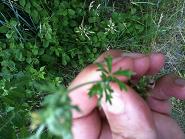
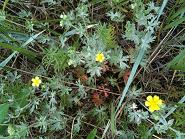
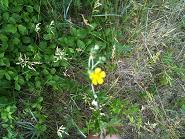
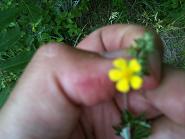

 My first Maryland Black Snakeroot tincture! See the description of this amazing plant
in the
Sanicula marilandica May Foraging Experiences section. Yesterday, I picked about 10
out of 50 plants in the area, washed the leaves and roots and then let them dry out a
bit until today. It took about 10 plants to make 1-1/2 pints of tincture.
(I also sprained my ankle on the way down the hill -- a sign to stay out of the field
for the first part of this week and catch up on my garden and other tasks.)
My first Maryland Black Snakeroot tincture! See the description of this amazing plant
in the
Sanicula marilandica May Foraging Experiences section. Yesterday, I picked about 10
out of 50 plants in the area, washed the leaves and roots and then let them dry out a
bit until today. It took about 10 plants to make 1-1/2 pints of tincture.
(I also sprained my ankle on the way down the hill -- a sign to stay out of the field
for the first part of this week and catch up on my garden and other tasks.)
 It will be very interesting to see if my own teas and medicines made from
freshly-picked herbs are more potent than the typical (and often non-wildcrafted)
store-bought herbal medicines.
It will be very interesting to see if my own teas and medicines made from
freshly-picked herbs are more potent than the typical (and often non-wildcrafted)
store-bought herbal medicines.
 This is the second of six New Hampshire cinquefoils that I am profiling.
I profiled the
Sulphur Cinquefoil in May. It is getting easier to tell them apart and the
Cinquefoil Identification page is helping. Silver Cinquefoil is a 6 to 12 inch plant
with leaves that contain 5-7 palmately-divided leaflets. The leaflets have a silver
back and a bird‘s-foot like toothing (unlike the other cinquefoils). The flower
is a 5-petals and yellow. While the images to the right seem to show a very light-colored
almost sulphur-colored yellow flower, the sunlight made it seem lighter-colored than it
really is.
This is the second of six New Hampshire cinquefoils that I am profiling.
I profiled the
Sulphur Cinquefoil in May. It is getting easier to tell them apart and the
Cinquefoil Identification page is helping. Silver Cinquefoil is a 6 to 12 inch plant
with leaves that contain 5-7 palmately-divided leaflets. The leaflets have a silver
back and a bird‘s-foot like toothing (unlike the other cinquefoils). The flower
is a 5-petals and yellow. While the images to the right seem to show a very light-colored
almost sulphur-colored yellow flower, the sunlight made it seem lighter-colored than it
really is.
 Common Cinquefoil (Potentilla simplex) is the most common of the cinquefoils in
my area and will be profiled next. The Canadian Dwarf Cinquefoil is one I need to locate.
It is only 2 to 6 inches high and the leaflets have teeth only on the top 1/2 of the
leaflet (unlike the Common Cinquefoil leaflet that has teeth on the top 2/3rds).
The other cinquefoils, Norwegian Cinquefoil (Potentilla norvegica) (has
leaves with only 3 leaflets) and Dwarf Mountain Cinquefoil (Potentilla
robbinsiana) (1/2 to 2 inch plant only found in alpine regions) will be profiled
if they are found.
Common Cinquefoil (Potentilla simplex) is the most common of the cinquefoils in
my area and will be profiled next. The Canadian Dwarf Cinquefoil is one I need to locate.
It is only 2 to 6 inches high and the leaflets have teeth only on the top 1/2 of the
leaflet (unlike the Common Cinquefoil leaflet that has teeth on the top 2/3rds).
The other cinquefoils, Norwegian Cinquefoil (Potentilla norvegica) (has
leaves with only 3 leaflets) and Dwarf Mountain Cinquefoil (Potentilla
robbinsiana) (1/2 to 2 inch plant only found in alpine regions) will be profiled
if they are found.




 I wandered up to this weed and said, “Hmmm. That looks like Mugwort!”
I must have seen it in a book or something. When I got home, I confirmed that it
is, in fact, Mugwort. A mature plant grows 2 to 4 feet tall. It has alternate leaves
that are deeply dissected (cut-out) in parts of the leaf. The front of the leaves
are green, but the back is covered with a silvery bed of hairs. As the leaf dries,
this silvery bed of hairs feels more like a soft cotton or velvet. Notice how the
edges of the leaves are pointy. As Mugwort leaves mature, the leaf lobes become
much bigger. The links to the pictures below show younger to older Mugwort leaves:
I wandered up to this weed and said, “Hmmm. That looks like Mugwort!”
I must have seen it in a book or something. When I got home, I confirmed that it
is, in fact, Mugwort. A mature plant grows 2 to 4 feet tall. It has alternate leaves
that are deeply dissected (cut-out) in parts of the leaf. The front of the leaves
are green, but the back is covered with a silvery bed of hairs. As the leaf dries,
this silvery bed of hairs feels more like a soft cotton or velvet. Notice how the
edges of the leaves are pointy. As Mugwort leaves mature, the leaf lobes become
much bigger. The links to the pictures below show younger to older Mugwort leaves:
 Before we discuss medicinal uses, it is important to differentiate Mugwort from plants
that we might confuse to be Mugwort. Common Ragweed (Ambrosia artemisiifolia) leaves
have some similarity to Mugwort. Carefully compare the top two images of the Mugwort
leaves (above and to the right) with
images of Common Ragweed. Notice how the leaves for Common Ragweed are much more dissected
(larger cut-out sections of the leaves) and that the tips of the leaves for Common Ragweed are
more rounded. After looking at these pictures, it should be very easy to differentiate
Mugwort and Common Ragweed.
Before we discuss medicinal uses, it is important to differentiate Mugwort from plants
that we might confuse to be Mugwort. Common Ragweed (Ambrosia artemisiifolia) leaves
have some similarity to Mugwort. Carefully compare the top two images of the Mugwort
leaves (above and to the right) with
images of Common Ragweed. Notice how the leaves for Common Ragweed are much more dissected
(larger cut-out sections of the leaves) and that the tips of the leaves for Common Ragweed are
more rounded. After looking at these pictures, it should be very easy to differentiate
Mugwort and Common Ragweed.
 Mugwort (Artemisia vulgaris) is one of several Artemisia species in
New Hampshire. Three species have similar leaves to Mugwort: 1) Absinthium
(Artemisia absinthium). Notice in the picture of Absinthium to the immediate
the right how both the front and back of the leaves are silver and that the edges are
much more rounded than Mugwort. 2) Biennial Wormwood (Artemisia biennis) has
leaves cut similar to that of Mugwort, but Biennial Wormwood is a more erect plant with
a thicker stem and shorter, feathery leaves with a large number of lobes and cut almost
to the midrib. Biennial Wormwood is a taller and thinner plant (in outline), while
Mugwort leaves grow out further from the stem making the plant wider and more like
a bush. 3) Roman Wormwood (Artemisia pontica) has leaves that are Grayish Green
while Mugwort leaves are green in the front and silver and hairy on the back. The
picture to the far right is a recent image of a Common Ragweed leaf.
Mugwort (Artemisia vulgaris) is one of several Artemisia species in
New Hampshire. Three species have similar leaves to Mugwort: 1) Absinthium
(Artemisia absinthium). Notice in the picture of Absinthium to the immediate
the right how both the front and back of the leaves are silver and that the edges are
much more rounded than Mugwort. 2) Biennial Wormwood (Artemisia biennis) has
leaves cut similar to that of Mugwort, but Biennial Wormwood is a more erect plant with
a thicker stem and shorter, feathery leaves with a large number of lobes and cut almost
to the midrib. Biennial Wormwood is a taller and thinner plant (in outline), while
Mugwort leaves grow out further from the stem making the plant wider and more like
a bush. 3) Roman Wormwood (Artemisia pontica) has leaves that are Grayish Green
while Mugwort leaves are green in the front and silver and hairy on the back. The
picture to the far right is a recent image of a Common Ragweed leaf. Finally the Mugwort leaf has some slight similarity to the
garden chrysanthemum leaf. In the image to the right, you can see the
leaf of one chrysanthemum, Feverfew (Tanacetum parthenium). Notice that it
has more teeth along the dissected edges. In addition, garden chrysanthemum leaves
are only slightly hair beneath while Mugwort has a very hairy silvery coating
beneath that can feel like velvet.
Finally the Mugwort leaf has some slight similarity to the
garden chrysanthemum leaf. In the image to the right, you can see the
leaf of one chrysanthemum, Feverfew (Tanacetum parthenium). Notice that it
has more teeth along the dissected edges. In addition, garden chrysanthemum leaves
are only slightly hair beneath while Mugwort has a very hairy silvery coating
beneath that can feel like velvet.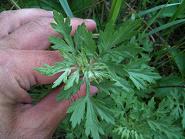
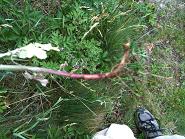
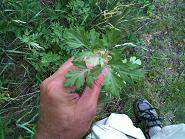
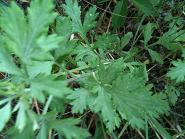

 I was not even looking for Sumac trees. Wandering into a hidden section of a
public park I came upon 4-5 Staghorn Sumac trees all in a row. They are low-growing
enough that I will easily be able to reach the fruit when it ready for harvesting
as dark red berries in late July or early August. Last year, I used Sumac fruit
given to me by my friend Judy to make a Sumac lemonaide. I crushed up the berries in
cold water, let it sit for a while, strained it and then added sweetener. Yummy!
I was not even looking for Sumac trees. Wandering into a hidden section of a
public park I came upon 4-5 Staghorn Sumac trees all in a row. They are low-growing
enough that I will easily be able to reach the fruit when it ready for harvesting
as dark red berries in late July or early August. Last year, I used Sumac fruit
given to me by my friend Judy to make a Sumac lemonaide. I crushed up the berries in
cold water, let it sit for a while, strained it and then added sweetener. Yummy!
 There are other Sumacs that have some similarities. Smooth Sumac (Rhus glabra)
(Edible fruit) is similar to Staghorn Sumac, but has smooth (hairless) stems and leaf
stalks (petioles). Winged Sumac (Rhus copallinum) (Edible fruit) grows 4-10 feet
tall, has raised dots on the stem and the 11-23 glossy leaflets have untoothed margins.
Poison Sumac (Toxicodendron vernix) (Inedible fruit) has white, hairless fruit
hairless stems and untoothed leaf margins. It tends to grow in swampy areas.
There are other Sumacs that have some similarities. Smooth Sumac (Rhus glabra)
(Edible fruit) is similar to Staghorn Sumac, but has smooth (hairless) stems and leaf
stalks (petioles). Winged Sumac (Rhus copallinum) (Edible fruit) grows 4-10 feet
tall, has raised dots on the stem and the 11-23 glossy leaflets have untoothed margins.
Poison Sumac (Toxicodendron vernix) (Inedible fruit) has white, hairless fruit
hairless stems and untoothed leaf margins. It tends to grow in swampy areas.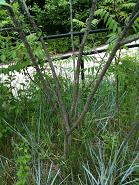
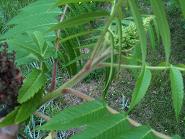
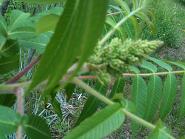
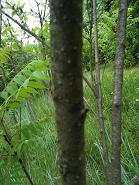





 The Eastern Daisy Fleabane is the most common fleabane in Southeastern, New Hampshire.
It grows in waste areas, by roadsides and in overgrown fields. It has a white (and
sometimes pink-tinged) flower rays (80-125 rays) surrounding a yellow disk made up of
100‘s of florets. The stem has noticeable hairs. The leaves are alternate up
the stem. They are hairy, lanceolate in shape and have some teeth (but not many). The
basal leaves are elliptic or round.
The Eastern Daisy Fleabane is the most common fleabane in Southeastern, New Hampshire.
It grows in waste areas, by roadsides and in overgrown fields. It has a white (and
sometimes pink-tinged) flower rays (80-125 rays) surrounding a yellow disk made up of
100‘s of florets. The stem has noticeable hairs. The leaves are alternate up
the stem. They are hairy, lanceolate in shape and have some teeth (but not many). The
basal leaves are elliptic or round.
 A very similar species is Prarie Fleabane (Rough Fleabane) (Erigeron strigosus).
Prarie Flebane tends to have fewer leaves on the stem. The stem hairs are less
noticeable since they are shorter and appressed against the stem. The leaves of
Prarie Fleabane are mostly hairless. In addition, the stem leaves of Prarie Fleabane
tend grow up to 1 inch wide, while Eastern Daisy Fleabane leaves grow to 2 inches in
width. Hmmm. I am going to keep a close watch on these fleabanes to make sure I can
differentiate between the Eastern Daisy Fleabane and the Prarie Fleabane.
A very similar species is Prarie Fleabane (Rough Fleabane) (Erigeron strigosus).
Prarie Flebane tends to have fewer leaves on the stem. The stem hairs are less
noticeable since they are shorter and appressed against the stem. The leaves of
Prarie Fleabane are mostly hairless. In addition, the stem leaves of Prarie Fleabane
tend grow up to 1 inch wide, while Eastern Daisy Fleabane leaves grow to 2 inches in
width. Hmmm. I am going to keep a close watch on these fleabanes to make sure I can
differentiate between the Eastern Daisy Fleabane and the Prarie Fleabane.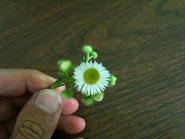
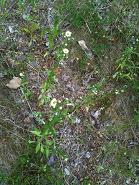
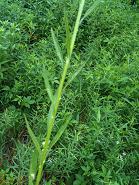

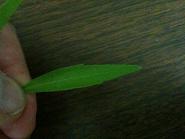
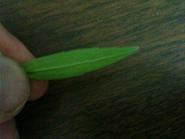

 This is a unique-looking plant! I have read in various places online that the seeds can be
used to make a condiment. However, the
Plants For A Future
database for Amorpha fruticosa suggests that there might be a hazard with
alkaloids in this plant. I have not seen any record of traditional uses as a condiment.
The
Plants For A Future
web page does have three references that say that it can used in this way.
This is a unique-looking plant! I have read in various places online that the seeds can be
used to make a condiment. However, the
Plants For A Future
database for Amorpha fruticosa suggests that there might be a hazard with
alkaloids in this plant. I have not seen any record of traditional uses as a condiment.
The
Plants For A Future
web page does have three references that say that it can used in this way.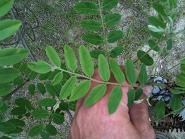
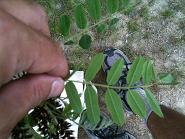
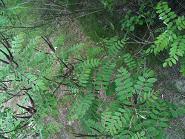

 In the process of learning foraging plants, I am trying to identify most of the flowering
plants that I see. Crown Vetch is a vine with alternate pinnately-compound leaves with
15 - 25 leaflets that are 1/2 - 3/4 inches long. There are obvious hairs on the back of
the stem. It flowers in June as a cluster of pink winged flowers forming a crown. The
stems of the flower (inner part of the cluster) are green with red streaks. Another
common vetch is profiled below,
Cow Vetch. Notice that the Crown Vetch has wider leaflets with a much less prominent
leaflet mid-vein as compared to the Cow Vetch. Also, the Cow Vetch has a hairless stem.
In the process of learning foraging plants, I am trying to identify most of the flowering
plants that I see. Crown Vetch is a vine with alternate pinnately-compound leaves with
15 - 25 leaflets that are 1/2 - 3/4 inches long. There are obvious hairs on the back of
the stem. It flowers in June as a cluster of pink winged flowers forming a crown. The
stems of the flower (inner part of the cluster) are green with red streaks. Another
common vetch is profiled below,
Cow Vetch. Notice that the Crown Vetch has wider leaflets with a much less prominent
leaflet mid-vein as compared to the Cow Vetch. Also, the Cow Vetch has a hairless stem.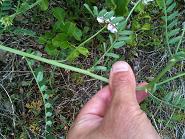
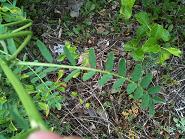

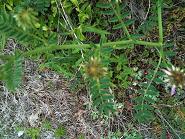

 Sweet Fern is a 1-4 foot shrub with many branches and a reddish-brown stem covered
with white hairs. The leaves are alternate up the stems and have scalloped edges
that make them look like fern leaves. Crushing the leaves give off a pleasant aromatic
fragerance. It grows in sandy or rocky soils near pine forest, clearings and in
woodlots.
Sweet Fern is a 1-4 foot shrub with many branches and a reddish-brown stem covered
with white hairs. The leaves are alternate up the stems and have scalloped edges
that make them look like fern leaves. Crushing the leaves give off a pleasant aromatic
fragerance. It grows in sandy or rocky soils near pine forest, clearings and in
woodlots.
 It can be used topically as a body deodorant and an
insect repellent. A chemical in Sweet Fern, Betulin has been
found to kill cancer cells for some types of cancer without harming healthy cells
around the cancer. A tea from the flowering tops has been used to treat headache,
fever, rheumatism and other conditions. Dried leaves thrown on a camp fire are
said to keep mosquitoes away. Native Americans used to line their baskets with
Sweet Fern leaves to help preserve fruit that they were picking.
It can be used topically as a body deodorant and an
insect repellent. A chemical in Sweet Fern, Betulin has been
found to kill cancer cells for some types of cancer without harming healthy cells
around the cancer. A tea from the flowering tops has been used to treat headache,
fever, rheumatism and other conditions. Dried leaves thrown on a camp fire are
said to keep mosquitoes away. Native Americans used to line their baskets with
Sweet Fern leaves to help preserve fruit that they were picking.
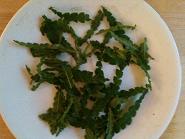
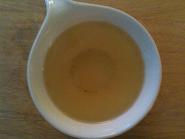
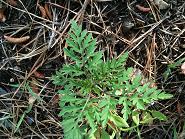
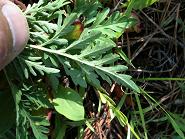
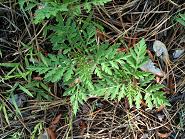
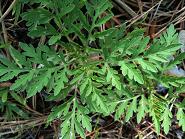
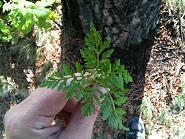
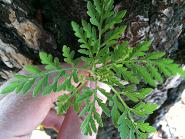
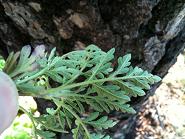


 I picked Autumn Olive fruit last year with my friends, Mike and Judy. But I never knew
how to identify this bush. Now that I can identify it, I see it almost everywhere!
The Autumn Olive and its relative, the Russian Olive (Elaeagnus angustifolia)
are deciduous shrubs/small trees with smooth gray bark. They have distinctive silvery
scales/dots on the young stems, leaves, flowers and fruits. The backs of the leaves
are an especially distinctive, somewhat translucent silver color. (See picture to the
right.) The leaves are alternate and slightly oval to lanceolate. They have untoothed
(entire) margins.
I picked Autumn Olive fruit last year with my friends, Mike and Judy. But I never knew
how to identify this bush. Now that I can identify it, I see it almost everywhere!
The Autumn Olive and its relative, the Russian Olive (Elaeagnus angustifolia)
are deciduous shrubs/small trees with smooth gray bark. They have distinctive silvery
scales/dots on the young stems, leaves, flowers and fruits. The backs of the leaves
are an especially distinctive, somewhat translucent silver color. (See picture to the
right.) The leaves are alternate and slightly oval to lanceolate. They have untoothed
(entire) margins.
 The front of the Autumn Olive leaves are a dull green color, but
are reported to become brighter green towards the Fall as some of the coloration rubs off.
On the other hand, the front of the Russian Olive leaves are a gray-green color and stay
like that all season. The Russian Olive leaves tend to be much thinner (more willow-like
according to Samuel Thayer)
and have a silvery sheen on both sides of the leaf.
The flowers (not shown) are light yellow and appear in May. The
fruit of Autumn Olive is a pink to red color with silver dots while the fruit of
Russian Olive is yellow or orange with silver dots. It is available for harvest in
late August through October. It is high in lycopene. I find the fruit of
the Russian Olive sweeter than that of the Autumn Olive, but the Russian Olive is
much more rare in Southeastern, New Hampshire.
The front of the Autumn Olive leaves are a dull green color, but
are reported to become brighter green towards the Fall as some of the coloration rubs off.
On the other hand, the front of the Russian Olive leaves are a gray-green color and stay
like that all season. The Russian Olive leaves tend to be much thinner (more willow-like
according to Samuel Thayer)
and have a silvery sheen on both sides of the leaf.
The flowers (not shown) are light yellow and appear in May. The
fruit of Autumn Olive is a pink to red color with silver dots while the fruit of
Russian Olive is yellow or orange with silver dots. It is available for harvest in
late August through October. It is high in lycopene. I find the fruit of
the Russian Olive sweeter than that of the Autumn Olive, but the Russian Olive is
much more rare in Southeastern, New Hampshire.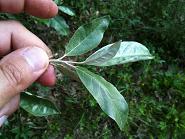
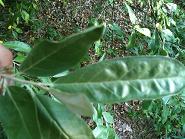
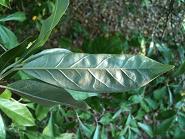

 I made Sweet Fern and Mugwort tinctures from the harvest of the foraging trip
in Manchester with my friend, Judy. There was an endless swath of Sweet Fern.
I didn‘t pick nearly enough Mugwort, so I picked more today to add to the
tincture and for some tea. Two pints of Sweet Fern tincture and one cup of
Mugwort tincture.
I made Sweet Fern and Mugwort tinctures from the harvest of the foraging trip
in Manchester with my friend, Judy. There was an endless swath of Sweet Fern.
I didn‘t pick nearly enough Mugwort, so I picked more today to add to the
tincture and for some tea. Two pints of Sweet Fern tincture and one cup of
Mugwort tincture.

 Two vetches seem to be very common in Southeastern, New Hampshire. The
Crown Vetch (Securigera varia) which I profiled earlier and even more
common is the Cow Vetch (which is known by many other names). It's official USDA
Plant Database name is Bird Vetch. Cow Vetch is a vine that has pinnately compound
leaves with 14-31 small leaflets. It has blue (or purple) flowers hanging down that
grow on one side of the stem only. The stems are hairless. Similar Vetches: Crown Vetch
(Securigera varia) has a pink flower growing in a clump and obvious hairs on
the back of the leaf stalk. Crown Vetch has wider leaflets with a much less prominent
leaflet mid-vein as compared to the Cow Vetch. Hairy Vetch (Vicia villosa) has
similar flowers to Cow Vetch except that parts of the flowers are both blue and whitish.
Also, the stalks of Hairy Vetch have hairs.
Two vetches seem to be very common in Southeastern, New Hampshire. The
Crown Vetch (Securigera varia) which I profiled earlier and even more
common is the Cow Vetch (which is known by many other names). It's official USDA
Plant Database name is Bird Vetch. Cow Vetch is a vine that has pinnately compound
leaves with 14-31 small leaflets. It has blue (or purple) flowers hanging down that
grow on one side of the stem only. The stems are hairless. Similar Vetches: Crown Vetch
(Securigera varia) has a pink flower growing in a clump and obvious hairs on
the back of the leaf stalk. Crown Vetch has wider leaflets with a much less prominent
leaflet mid-vein as compared to the Cow Vetch. Hairy Vetch (Vicia villosa) has
similar flowers to Cow Vetch except that parts of the flowers are both blue and whitish.
Also, the stalks of Hairy Vetch have hairs.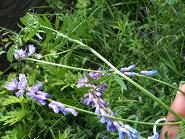
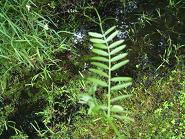
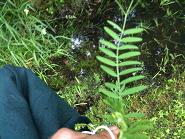
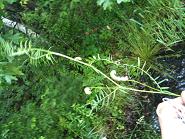
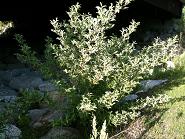
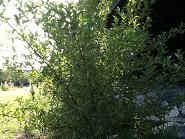
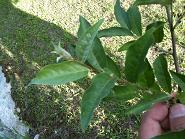
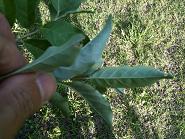
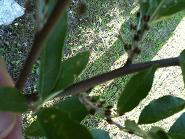
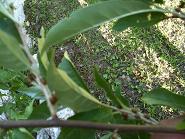
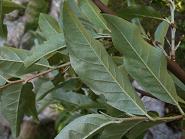
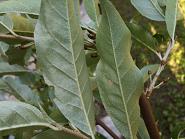
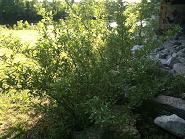

 A 5-petal pink flower on a thin, grass-like stalk. The flower petals are toothed at
the tip. There are white and dark red dots at the center of the flower. Leaves are
opposite and lanceolate in shape. They clasp the stem. The stem is hairless. Maiden
Pink is similar to Deptford Pink (Dianthus armeria) except that Deptford Pink
has flowers in clusters atop a stiff erect stem rather than the solitary flower for
Maiden Pink.
A 5-petal pink flower on a thin, grass-like stalk. The flower petals are toothed at
the tip. There are white and dark red dots at the center of the flower. Leaves are
opposite and lanceolate in shape. They clasp the stem. The stem is hairless. Maiden
Pink is similar to Deptford Pink (Dianthus armeria) except that Deptford Pink
has flowers in clusters atop a stiff erect stem rather than the solitary flower for
Maiden Pink.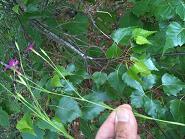

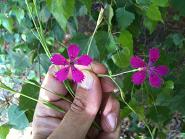
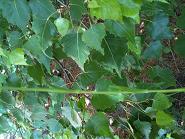

 This is a plant I would like to be able to identify next year before the flowers appear.
Whorled Yellow Loosestrife is an erect, 1 to 3 foot plant with whorls of 3 to 6 leaves
going up the stem. The leaves lanceolate in shape and are 2 to 4 inches long. As can be
seen in the pictures, the stem is hairy. Also notice that the upper leaves sometimes turn
a purplish color. Each plant has numerous 5-petal yellow flowers marked with red dots at
the center. Whorled Yellow Loosestrife is similar to Garden Yellow Loosestrife
(Lysimachia vulgaris) except that Garden Yellow Loosestrife has many more flowers
that are less delicate. The Garden Yellow Loosestrife flower petals are much wider and
overlap.
This is a plant I would like to be able to identify next year before the flowers appear.
Whorled Yellow Loosestrife is an erect, 1 to 3 foot plant with whorls of 3 to 6 leaves
going up the stem. The leaves lanceolate in shape and are 2 to 4 inches long. As can be
seen in the pictures, the stem is hairy. Also notice that the upper leaves sometimes turn
a purplish color. Each plant has numerous 5-petal yellow flowers marked with red dots at
the center. Whorled Yellow Loosestrife is similar to Garden Yellow Loosestrife
(Lysimachia vulgaris) except that Garden Yellow Loosestrife has many more flowers
that are less delicate. The Garden Yellow Loosestrife flower petals are much wider and
overlap.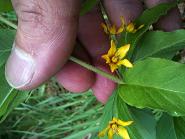
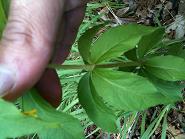
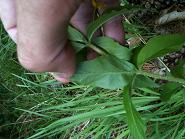
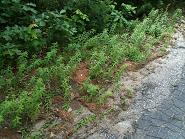
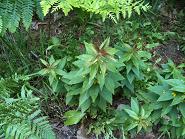
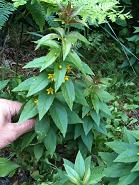
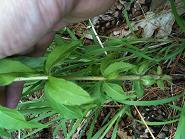
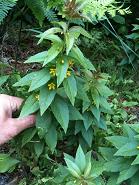

 A large yellow dasiy-like flower that is divided into 8 separate rays. Each flower
ray contains 3 to 5 distinct lobes. The plant is erect and grows 1 to 2 feet tall.
It has a hairy stem. The leaves are long (3-6 inches at the base), untoothed and
lanceolate in shape. Lanceleaf Tickseed is part of the Aster family.
A large yellow dasiy-like flower that is divided into 8 separate rays. Each flower
ray contains 3 to 5 distinct lobes. The plant is erect and grows 1 to 2 feet tall.
It has a hairy stem. The leaves are long (3-6 inches at the base), untoothed and
lanceolate in shape. Lanceleaf Tickseed is part of the Aster family.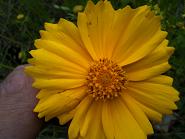
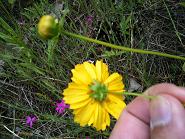
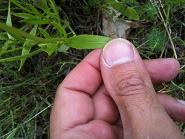
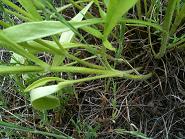
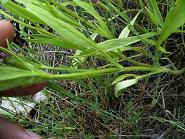

 Longbranch Frostweed is an erect plant with a 5-petal yellow flower. The flower petals
overlap sometimes making the flower look like a little yellow satellite dish.
The very center part of the flower is white surrounded by orange-tipped stamen.
Stems have 1 to 2 flowers that bloom in May-June. Leaves are alternate,
narrowly-oblong and taper at both the base and the tip. Stems are scattered and
branching and the branches become longer than the main stem. This differentiates
it from the very similar species, Hoary Frostweed (Helianthemum bicknellii)
where the branches do not become longer than the main stem. In addition, Hoary
Frostweed tends to have more flowers (2-10) and blooms later in the year
(June-July).
Longbranch Frostweed is an erect plant with a 5-petal yellow flower. The flower petals
overlap sometimes making the flower look like a little yellow satellite dish.
The very center part of the flower is white surrounded by orange-tipped stamen.
Stems have 1 to 2 flowers that bloom in May-June. Leaves are alternate,
narrowly-oblong and taper at both the base and the tip. Stems are scattered and
branching and the branches become longer than the main stem. This differentiates
it from the very similar species, Hoary Frostweed (Helianthemum bicknellii)
where the branches do not become longer than the main stem. In addition, Hoary
Frostweed tends to have more flowers (2-10) and blooms later in the year
(June-July).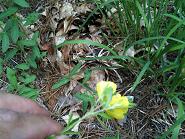

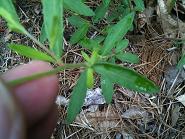
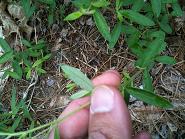

 Spreading Dogbane (Apocynum androsaemifolium) is one of the dogbanes that
can look a little bit like the edible Common Milkweed (Asclepias syriaca).
However, since it is a spreading, bushy plant it looks less like Milkweed than
other more erect dogbanes such as Indian Hemp (Apocynum cannabinum).
Spreading Dogbane (Apocynum androsaemifolium) is one of the dogbanes that
can look a little bit like the edible Common Milkweed (Asclepias syriaca).
However, since it is a spreading, bushy plant it looks less like Milkweed than
other more erect dogbanes such as Indian Hemp (Apocynum cannabinum).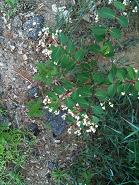
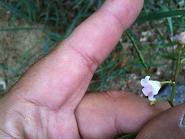
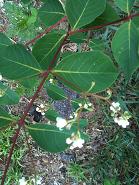
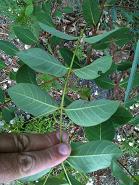

 Another cinquefoil for my
Cinquefoil Identification web page. This is the most common of the cinquefoils --
Common Cinquefoil (Potentilla simplex).
Flowers on solitary stem arising out of a leaf axil. The first flower arises from the
2nd leaf axil from the bottom (This differentiates Common Cinquefoil from
Canadian Dwarf Cinquefoil (Potentilla canadensis) which has the flower arise
from the 1st leaf axil from the bottom). While this plant can be tall, often times
the stem droops or folds down over other plants.
Another cinquefoil for my
Cinquefoil Identification web page. This is the most common of the cinquefoils --
Common Cinquefoil (Potentilla simplex).
Flowers on solitary stem arising out of a leaf axil. The first flower arises from the
2nd leaf axil from the bottom (This differentiates Common Cinquefoil from
Canadian Dwarf Cinquefoil (Potentilla canadensis) which has the flower arise
from the 1st leaf axil from the bottom). While this plant can be tall, often times
the stem droops or folds down over other plants.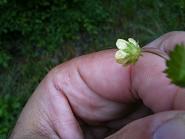
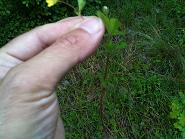
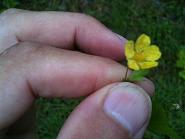
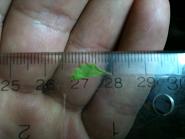


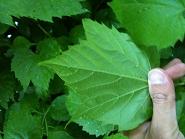
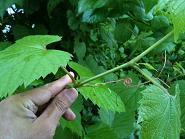
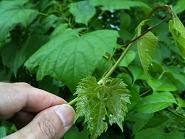

 Tall Meadow Rue is common in New Hampshire. It is easily recognized by the
slightly lobed (3-lobed) leaflets and the ball of white spikes the comprise
the flower. The leaf blade is ternately and pinnately decompound. That means
that the leaf blade is divided and sometimes further subdivided into three
(ternately) parts or two (pinnately) parts. Not all of the leaflets have
three lobes. The leaflets are not toothed.
Tall Meadow Rue is common in New Hampshire. It is easily recognized by the
slightly lobed (3-lobed) leaflets and the ball of white spikes the comprise
the flower. The leaf blade is ternately and pinnately decompound. That means
that the leaf blade is divided and sometimes further subdivided into three
(ternately) parts or two (pinnately) parts. Not all of the leaflets have
three lobes. The leaflets are not toothed.
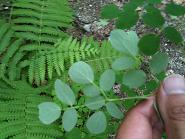
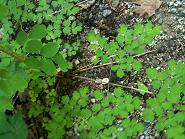
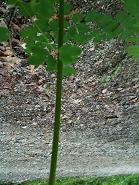

 Oxeye Daisy and Red Clover blossom wine was started today!!! Went out and
picked 1-1/2 gallons of Oxeye Daisy blossoms and 1-1/2 gallons of Red Clover blossoms.
That was a lot of looking and picking, picking and looking! Thank you to Kevin for
helping and to Jennifer for finding my more Ground Ivy! The good news is that
I know some fantastic sites for large amounts of Oxeye Daisy and Red Clover. The extra
Oxeye Daisy leaves will be used to spice up a salad. The extra Red Clover blossoms will
be used for tincture and to dry for tea. Red Clover is a fantastic blood cleanser and
is said to be a very important herb in the treatment of cancer.
Oxeye Daisy and Red Clover blossom wine was started today!!! Went out and
picked 1-1/2 gallons of Oxeye Daisy blossoms and 1-1/2 gallons of Red Clover blossoms.
That was a lot of looking and picking, picking and looking! Thank you to Kevin for
helping and to Jennifer for finding my more Ground Ivy! The good news is that
I know some fantastic sites for large amounts of Oxeye Daisy and Red Clover. The extra
Oxeye Daisy leaves will be used to spice up a salad. The extra Red Clover blossoms will
be used for tincture and to dry for tea. Red Clover is a fantastic blood cleanser and
is said to be a very important herb in the treatment of cancer.
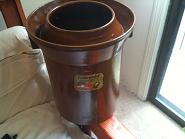
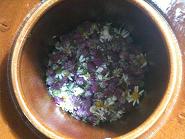

 The 4th in the line of cinquefoils for the
Cinquefoil Identification web page. Fortunately, all of the four cinquefoils I have
found so far are very different.
The 4th in the line of cinquefoils for the
Cinquefoil Identification web page. Fortunately, all of the four cinquefoils I have
found so far are very different.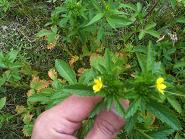
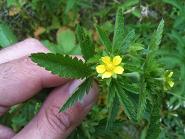


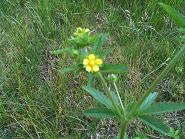
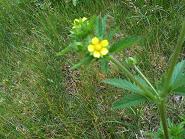
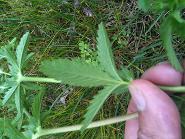




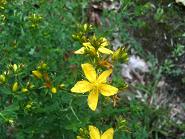
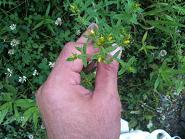
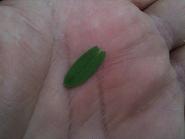
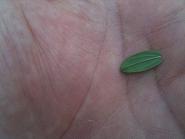




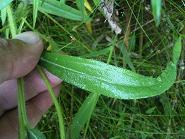
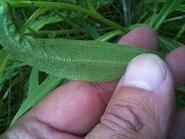
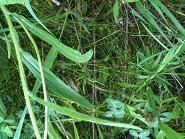
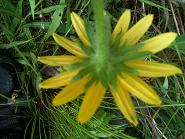




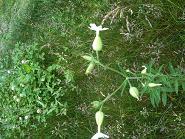
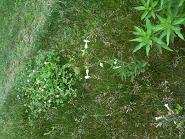
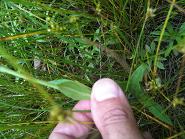
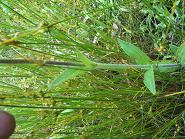


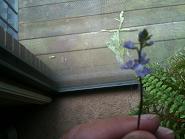
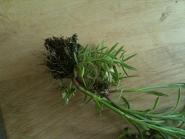
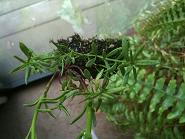
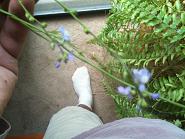

 Now let us look at pictures and go over each item in the above list:
Now let us look at pictures and go over each item in the above list:

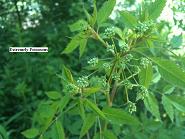
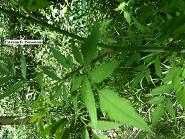

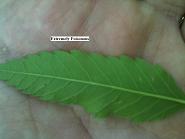


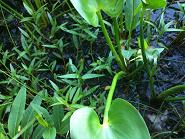
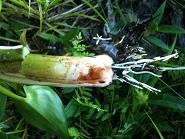
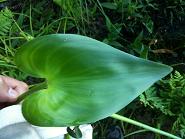
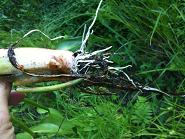


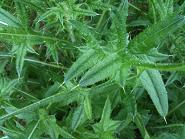
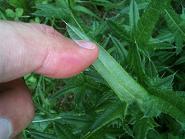
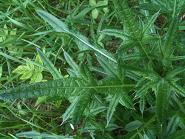
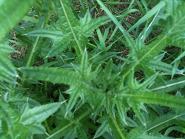


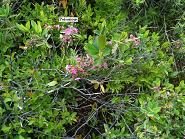
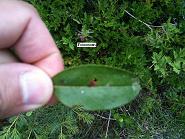
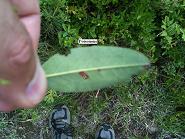
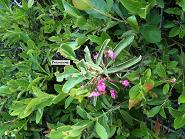






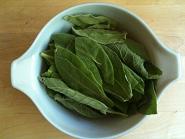
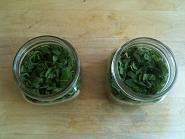
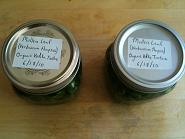
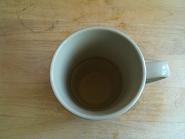



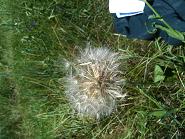
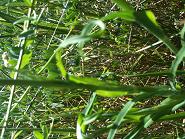
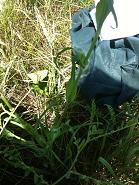
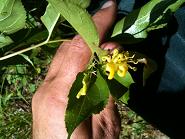
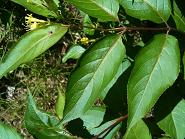
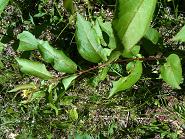





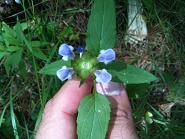
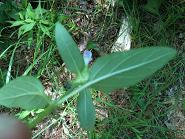
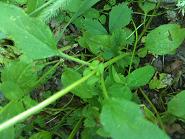
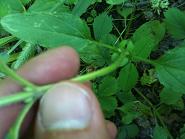


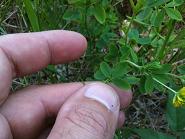
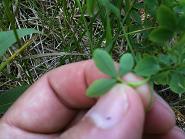
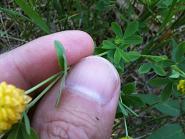
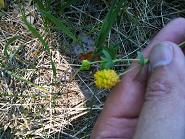


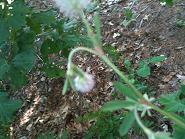
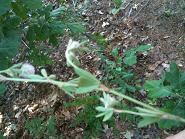
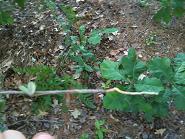

 Arrowhead is one of the more important foraging plants. The main crop from Arrowhead
are the potato like roots that can be harvested in the Fall. Arrowhead grows near
the shores of marshes, ponds and rivers, so it will require getting a bit wet to harvest.
Harvesting the root requires feeling in the mud/muck with your hands to grab and pull
off the root or by stomping and moving around in the mud to loosen the tubers until
they float to the surface. Arrowhead root can be prepared by cleaning and peeling the
tubers and then using them like potatoes. They can be cooked for 30 minutes and then
the water drained. They can then be mashed for mashed potatoes. You can dry and then
coarsly grind the mashed potatoes to store as an instant cereal. Undamaged potatoes
can be stored in a root cellar if kept slightly moist and not piled too deeply.
Arrowhead is one of the more important foraging plants. The main crop from Arrowhead
are the potato like roots that can be harvested in the Fall. Arrowhead grows near
the shores of marshes, ponds and rivers, so it will require getting a bit wet to harvest.
Harvesting the root requires feeling in the mud/muck with your hands to grab and pull
off the root or by stomping and moving around in the mud to loosen the tubers until
they float to the surface. Arrowhead root can be prepared by cleaning and peeling the
tubers and then using them like potatoes. They can be cooked for 30 minutes and then
the water drained. They can then be mashed for mashed potatoes. You can dry and then
coarsly grind the mashed potatoes to store as an instant cereal. Undamaged potatoes
can be stored in a root cellar if kept slightly moist and not piled too deeply.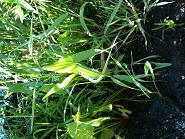
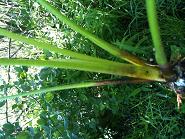
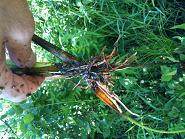
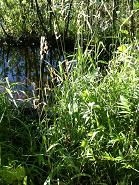
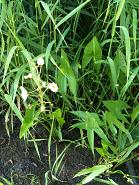
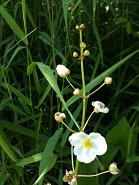
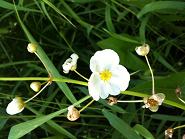
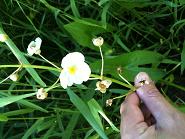


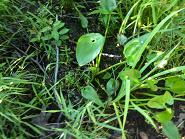
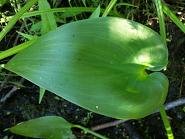
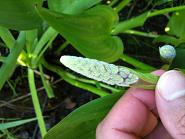
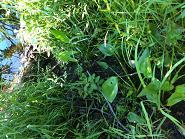




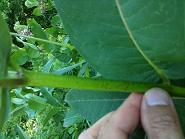
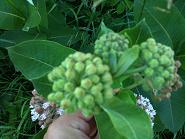
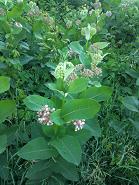
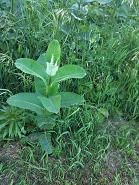
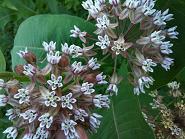


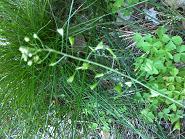
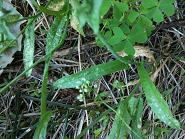
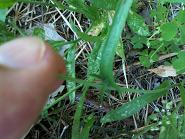


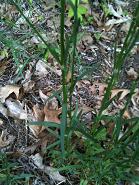

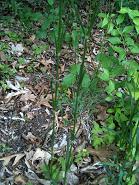
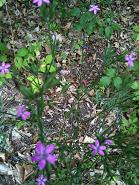

 I have not seen Common Toadflax very often -- one plant last year and this year I saw a few plants just
outside a small path leading to a park. Common Toadflax was traditionally
used as a digestive bitter. It stimulates liver and gallbladder secretion and
helps to decongest and repair liver stress from a poor diet or malabsorption.
The whole above-ground portion is used in decoction, infusion or tincture.
I have not seen Common Toadflax very often -- one plant last year and this year I saw a few plants just
outside a small path leading to a park. Common Toadflax was traditionally
used as a digestive bitter. It stimulates liver and gallbladder secretion and
helps to decongest and repair liver stress from a poor diet or malabsorption.
The whole above-ground portion is used in decoction, infusion or tincture.
 A yellow, 2-lipped flower with bright orange ridges. The leaves are long, very thin
(grass-like) and alternate up the stem. Lower leaves are opposite or whorled. Grows
in dry fields, roadsides and waste places.
A yellow, 2-lipped flower with bright orange ridges. The leaves are long, very thin
(grass-like) and alternate up the stem. Lower leaves are opposite or whorled. Grows
in dry fields, roadsides and waste places.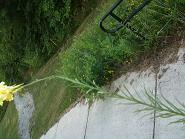
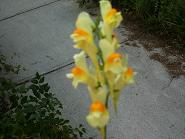
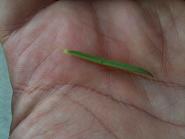
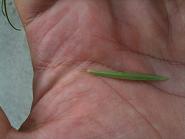

 When Dogbane is young it looks somewhat similar to young Milkweed. Milkweed is edible
and Dogbane is inedible. But dried Dogbane stalks can be used to make cord.
When Dogbane is young it looks somewhat similar to young Milkweed. Milkweed is edible
and Dogbane is inedible. But dried Dogbane stalks can be used to make cord.
 Common Milkweed (Asclepias syriaca) has a stem that is squarish in cross section,
leaf size decreases going up the stalk and overlaps significantly (if folded upward),
leaf bottom and stem is hairy, shoot is shorter and thicker. Common Dogbane has a stem
that is round in cross section, leaf size increases going up the stalk and overlaps
only slightly if any, leaf bottom and stem is smooth and hairless, shoot is taller and
thinner. Young Milkweed stems tend to be green, while young Dogbane stems have a faint
redish bloom or spots.
Common Milkweed (Asclepias syriaca) has a stem that is squarish in cross section,
leaf size decreases going up the stalk and overlaps significantly (if folded upward),
leaf bottom and stem is hairy, shoot is shorter and thicker. Common Dogbane has a stem
that is round in cross section, leaf size increases going up the stalk and overlaps
only slightly if any, leaf bottom and stem is smooth and hairless, shoot is taller and
thinner. Young Milkweed stems tend to be green, while young Dogbane stems have a faint
redish bloom or spots.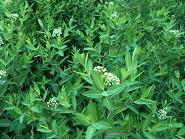
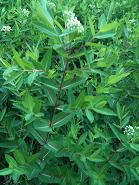
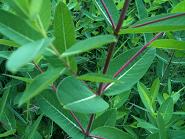
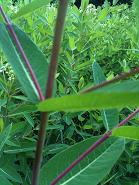

 There are a couple of very important reasons to locate a good source of White Oak
trees. The acorns are a very important food source. While any type of oak tree acorns
can be used, the White Oak acorns tends to contain fewer tannis and therefore needs
much less leaching. Inner White Oak bark is a very power medicine. It is especially
useful for persons
who tend towards poor digestion, loose teeth or teeth with lots of cavities, poorly-toned
intestines, swollen spleen and poor nutrient assimilation. It can be combined with
dandelion root in a decoction to help remineralize the bones and teeth.
There are a couple of very important reasons to locate a good source of White Oak
trees. The acorns are a very important food source. While any type of oak tree acorns
can be used, the White Oak acorns tends to contain fewer tannis and therefore needs
much less leaching. Inner White Oak bark is a very power medicine. It is especially
useful for persons
who tend towards poor digestion, loose teeth or teeth with lots of cavities, poorly-toned
intestines, swollen spleen and poor nutrient assimilation. It can be combined with
dandelion root in a decoction to help remineralize the bones and teeth.
 White Oak leaves have rounded lobes. The bark is grayish-silver and looks
like it is stretched thin. The inner bark is white. A recently downed tree or the
branches can be used to harvest the inner bark. White Oak acorns can be harvested
in the Fall.
White Oak leaves have rounded lobes. The bark is grayish-silver and looks
like it is stretched thin. The inner bark is white. A recently downed tree or the
branches can be used to harvest the inner bark. White Oak acorns can be harvested
in the Fall.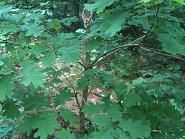
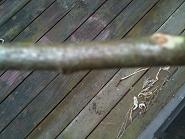

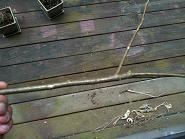

 This was a confusing and frustrating plant to identify! It looked so much like
Solomon‘s Seal with the exception that the stem forked into two Solomon‘s
Seal-like arching stems and instead of inedible fruit beneath the leaves, there is
a green, 3-parted, triangular pod. With a lot of research and the help of Judy,
we identified this plant. One of the biggest helpful web pages was this Minnesota
web page on Solomon‘s Seal identification and look-alikes:
This was a confusing and frustrating plant to identify! It looked so much like
Solomon‘s Seal with the exception that the stem forked into two Solomon‘s
Seal-like arching stems and instead of inedible fruit beneath the leaves, there is
a green, 3-parted, triangular pod. With a lot of research and the help of Judy,
we identified this plant. One of the biggest helpful web pages was this Minnesota
web page on Solomon‘s Seal identification and look-alikes:
 The leaves are usually 1-1/2 to 3 inches long growing on a stem that is not
straight. The leaves are light green above and slightly whitish below.
The leaf veins are parallel. As mentioned above, the stem forks into two
Solomon‘s Seal-like arching stems. Flowers (not shown) are narrow,
bell-shaped and hang beneath the leaves. After flowering a green, somewhat
round, somewhat triangular pod hangs beneath the leaves. Inside the pod
are tiny round white seeds.
The leaves are usually 1-1/2 to 3 inches long growing on a stem that is not
straight. The leaves are light green above and slightly whitish below.
The leaf veins are parallel. As mentioned above, the stem forks into two
Solomon‘s Seal-like arching stems. Flowers (not shown) are narrow,
bell-shaped and hang beneath the leaves. After flowering a green, somewhat
round, somewhat triangular pod hangs beneath the leaves. Inside the pod
are tiny round white seeds.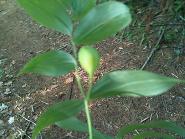

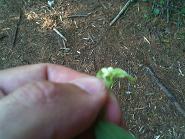
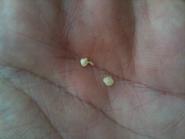

 This plant shows quite a bit of variation. The first plant I saw had 6 big flowers
at the top and whorls of 8-10 leaves going up the stem. But most of the Canada
Lilies along the trail had whorls of 4 leaves and only 1 flower at the top (see
2nd row of pictures in the table below). I thought it might be two different
plants, but according to the guidebooks, it just shows quite a bit of variation.
This plant shows quite a bit of variation. The first plant I saw had 6 big flowers
at the top and whorls of 8-10 leaves going up the stem. But most of the Canada
Lilies along the trail had whorls of 4 leaves and only 1 flower at the top (see
2nd row of pictures in the table below). I thought it might be two different
plants, but according to the guidebooks, it just shows quite a bit of variation.
 The leaves are lanceolate and appear in whorls of 4-10 leaves on the stem. The veins
beneath the leaves have minute prickles. The large yellow flowers have 3 petals and 3
petal-like sepals (making it seem like it has 6 petals). There are dark redish-brown
spots on the flower petals. There are six stamen with brown anthers. Up to 20 flowers
may be borne on the same plant.
The leaves are lanceolate and appear in whorls of 4-10 leaves on the stem. The veins
beneath the leaves have minute prickles. The large yellow flowers have 3 petals and 3
petal-like sepals (making it seem like it has 6 petals). There are dark redish-brown
spots on the flower petals. There are six stamen with brown anthers. Up to 20 flowers
may be borne on the same plant.